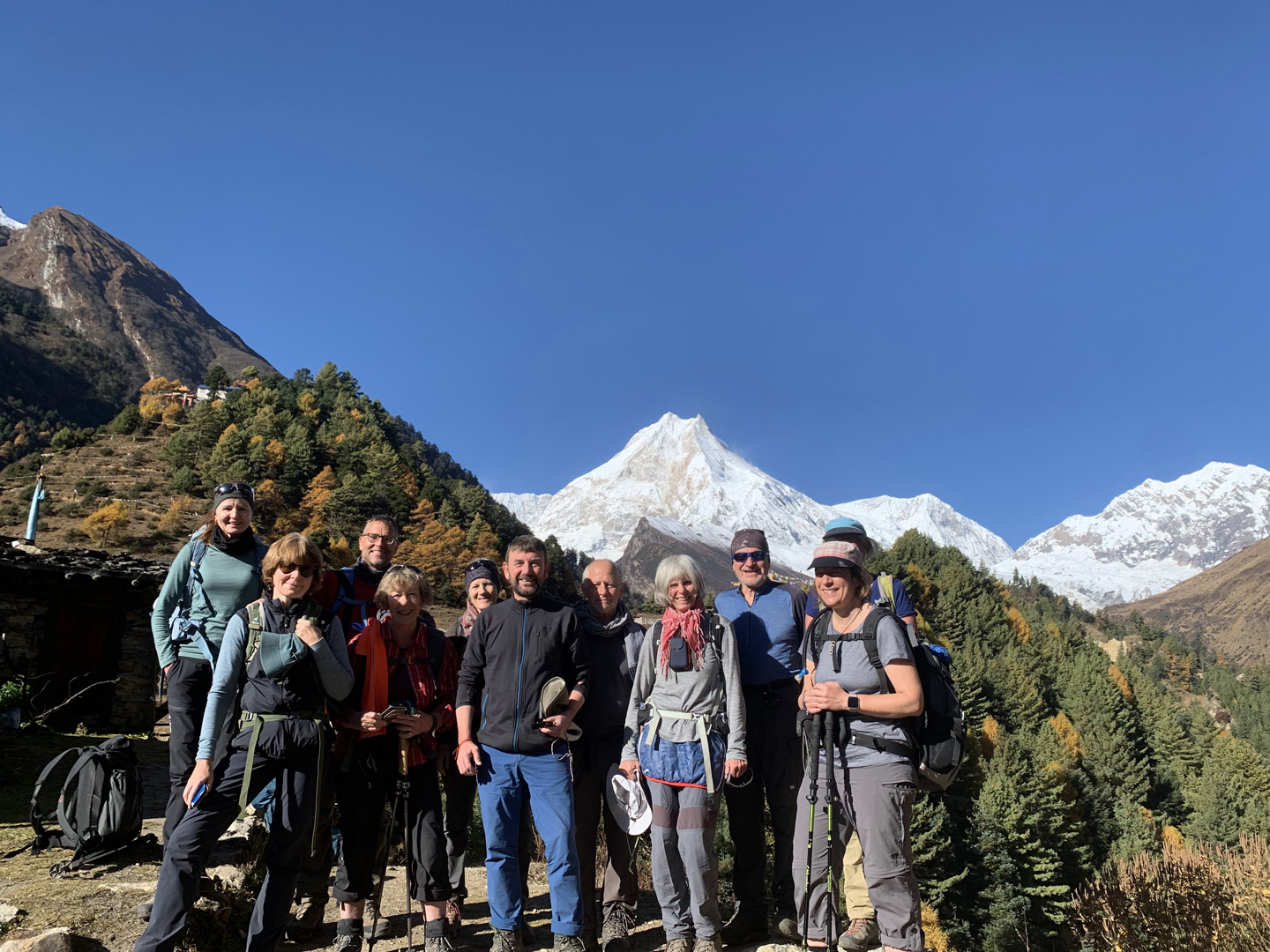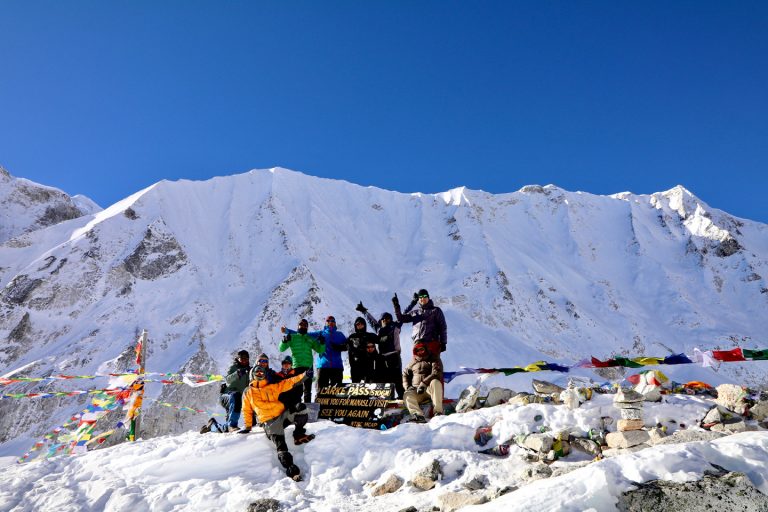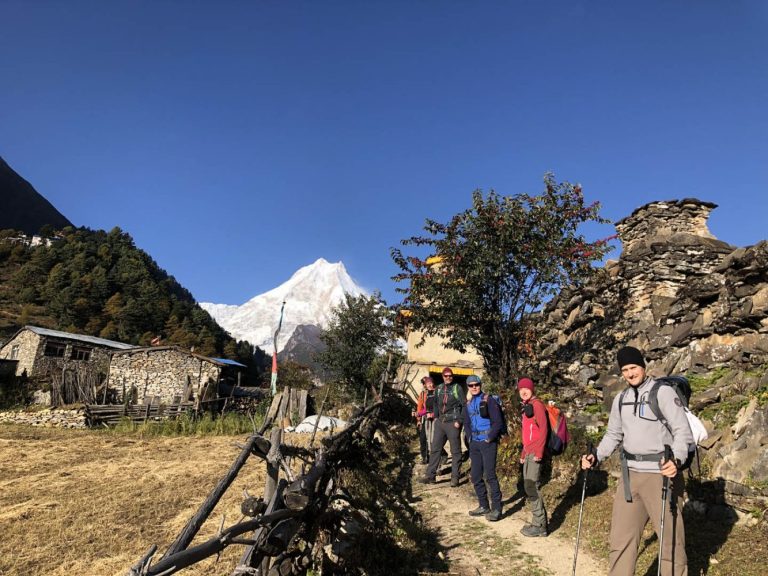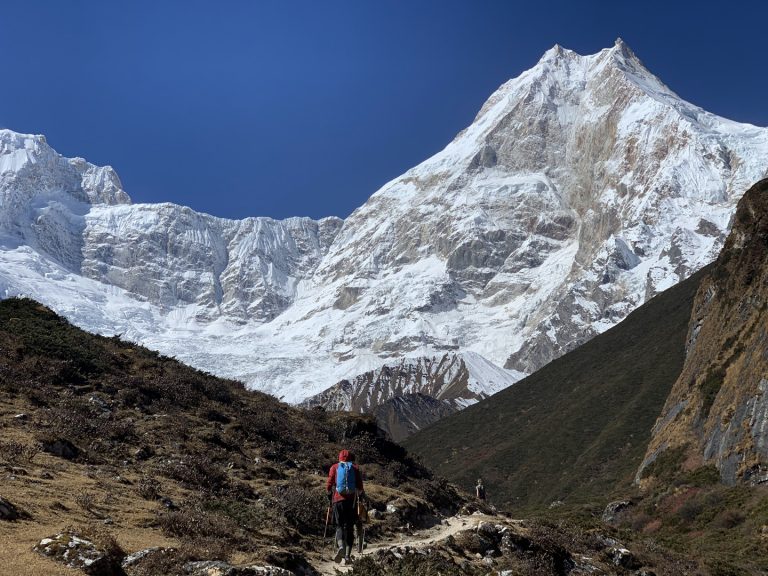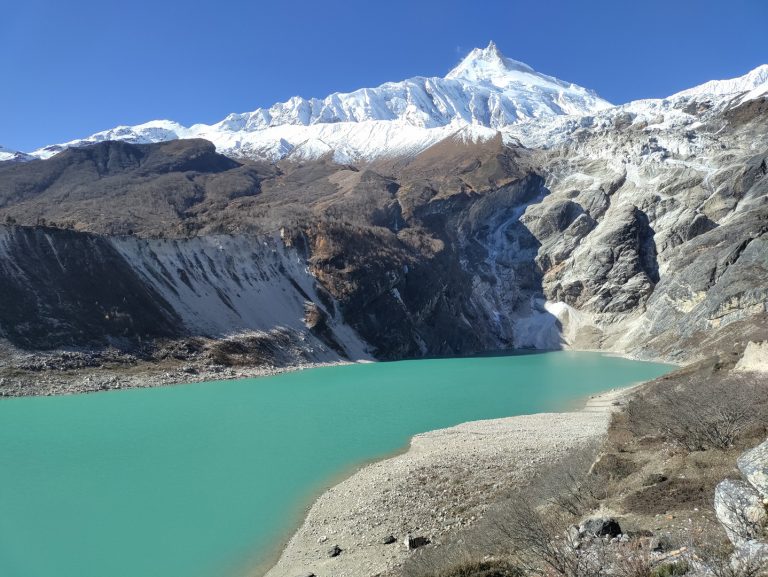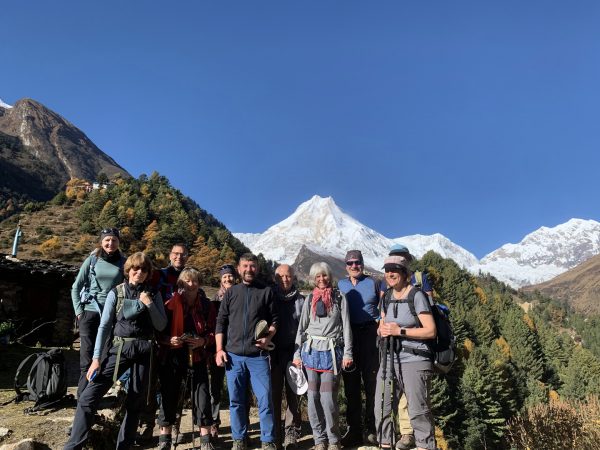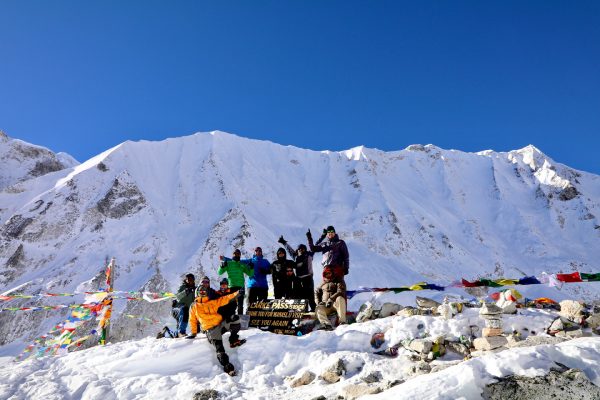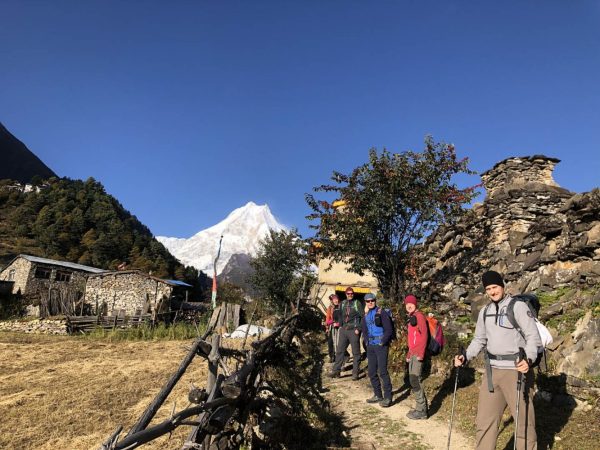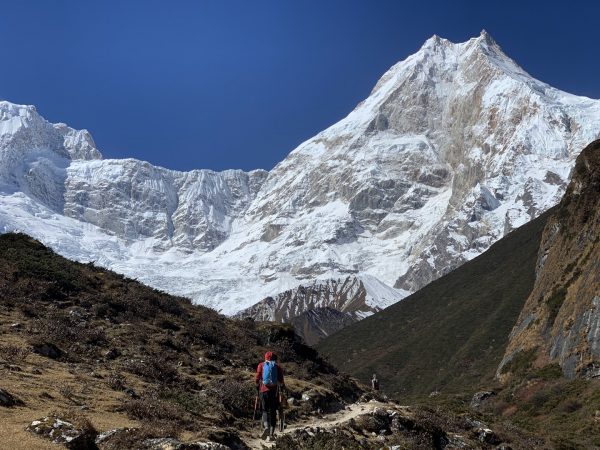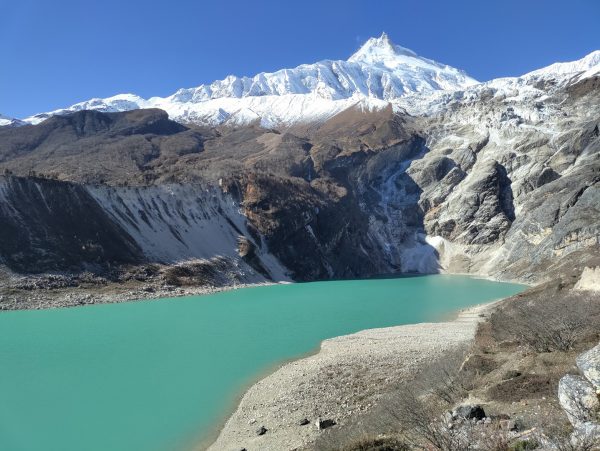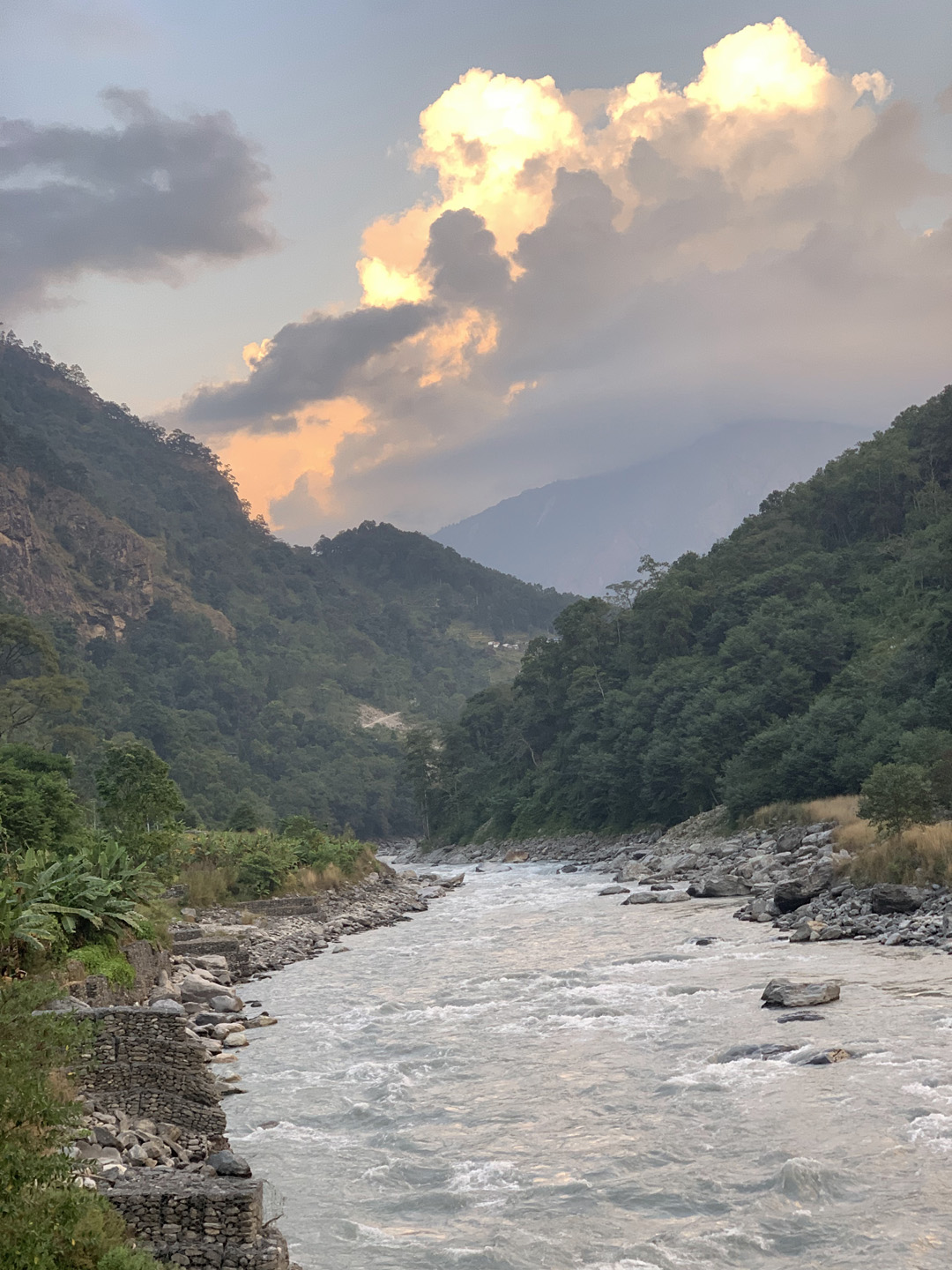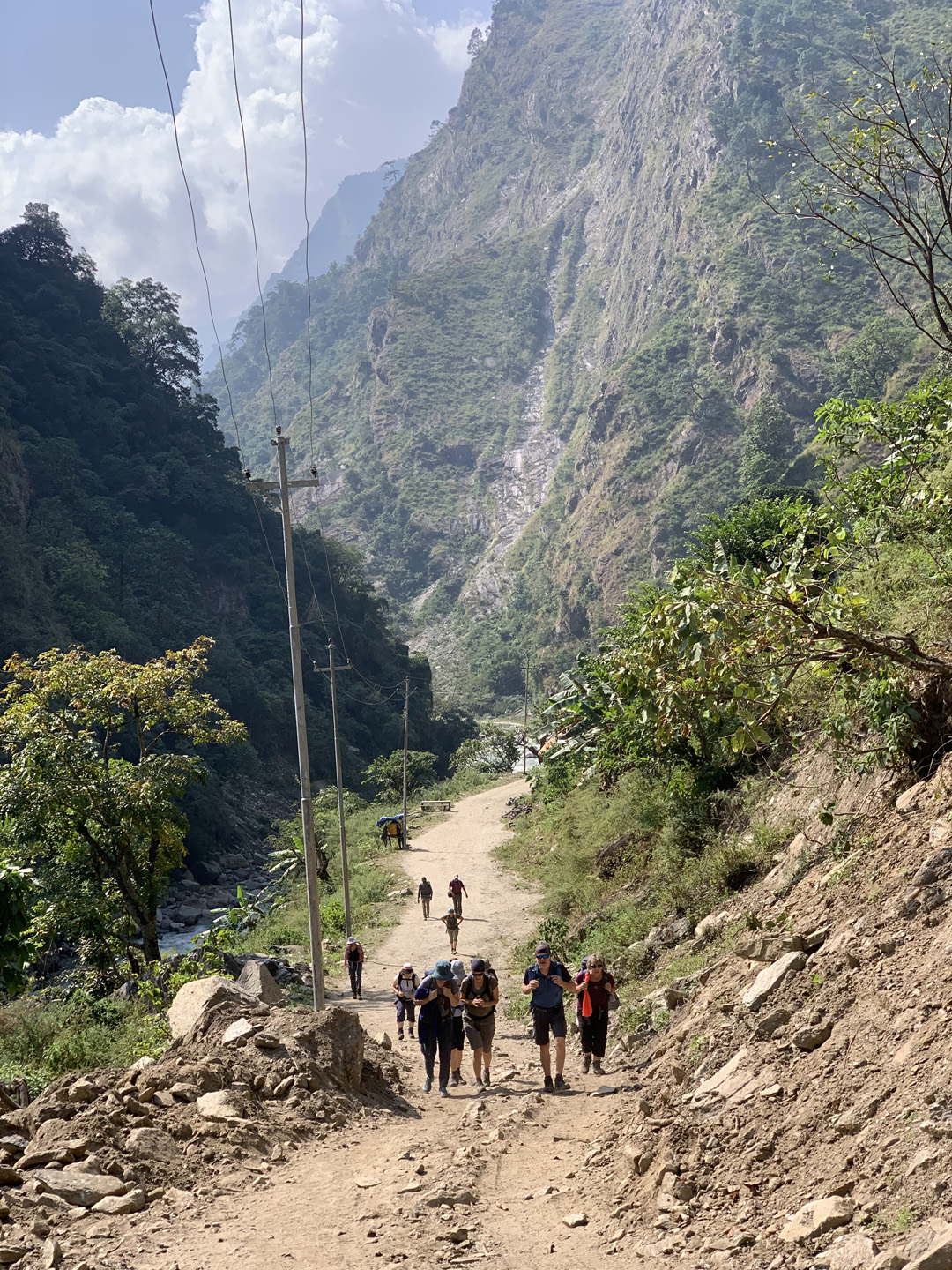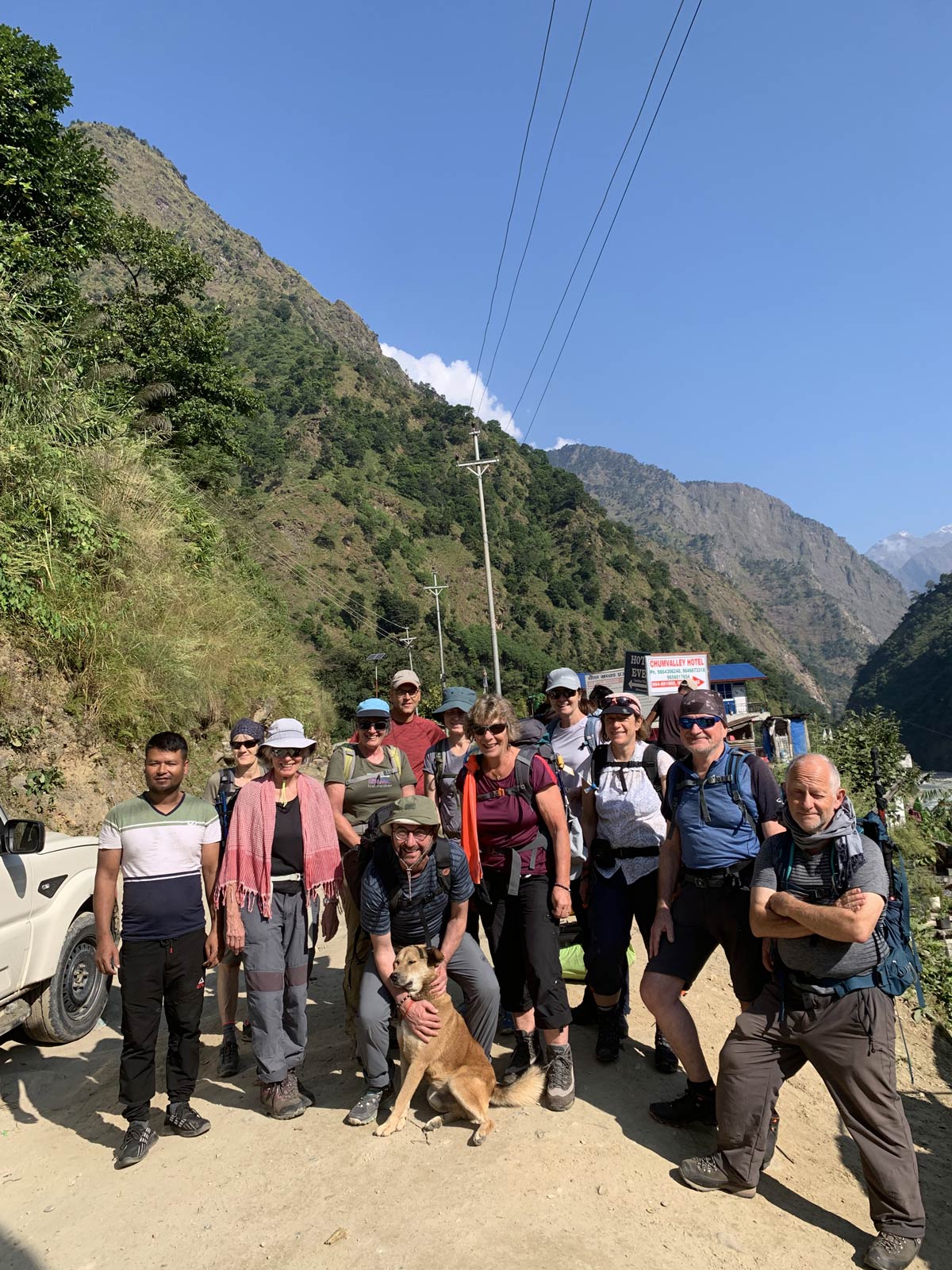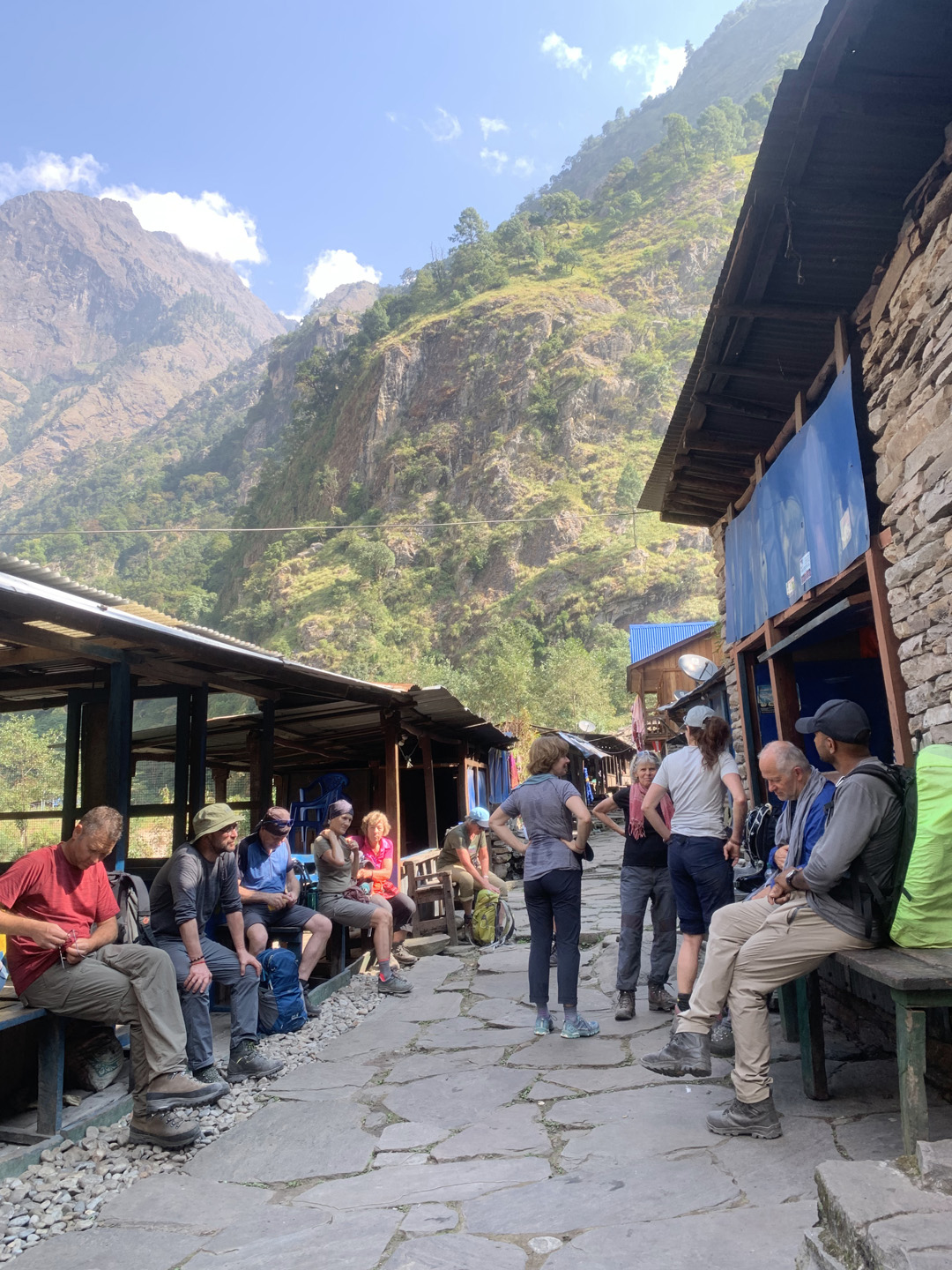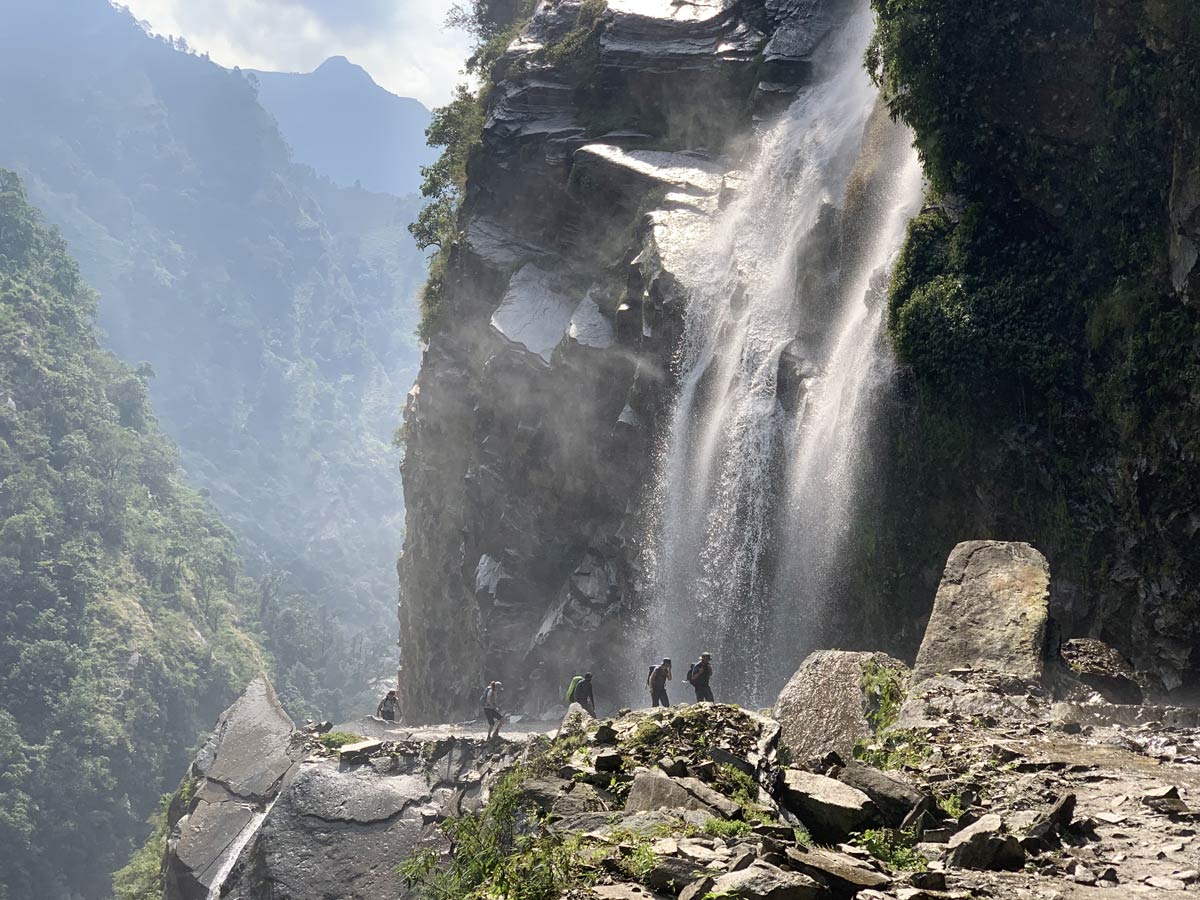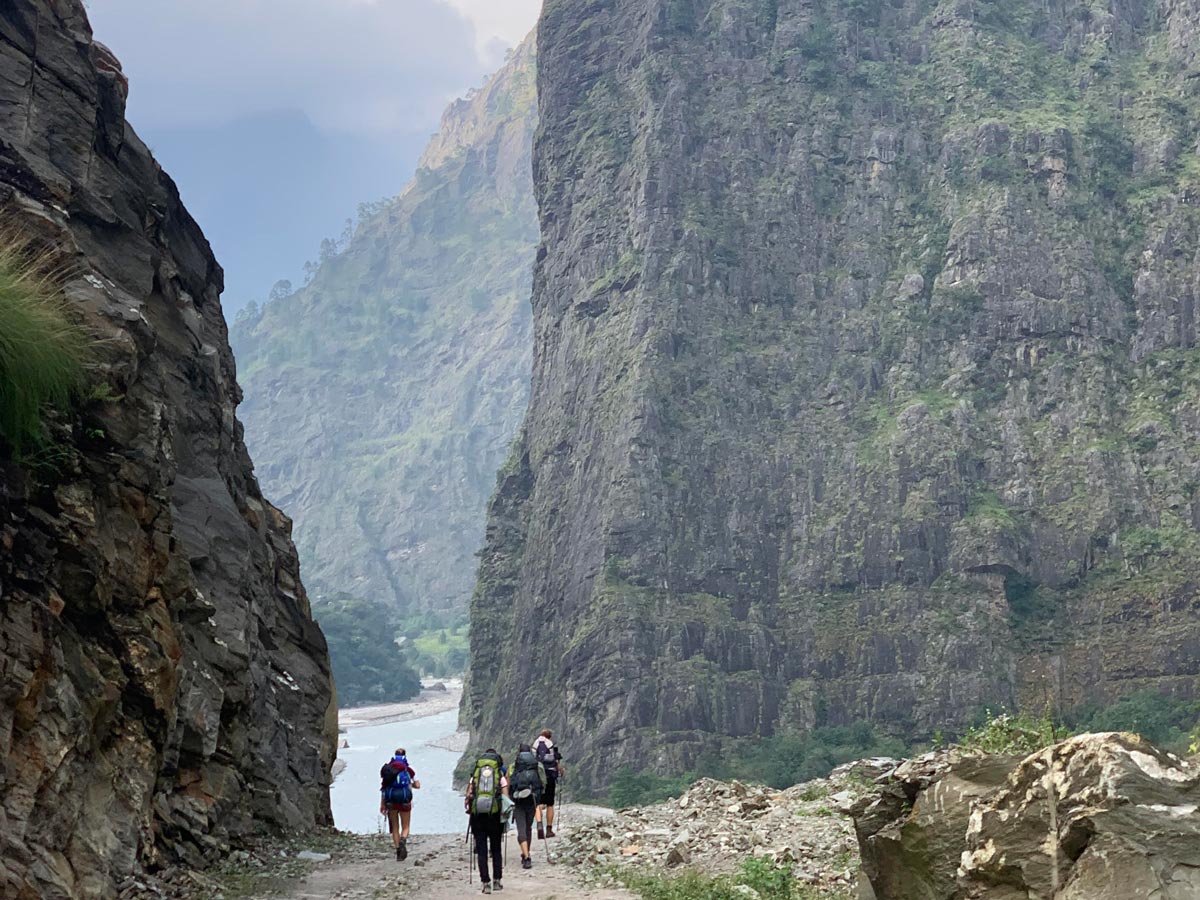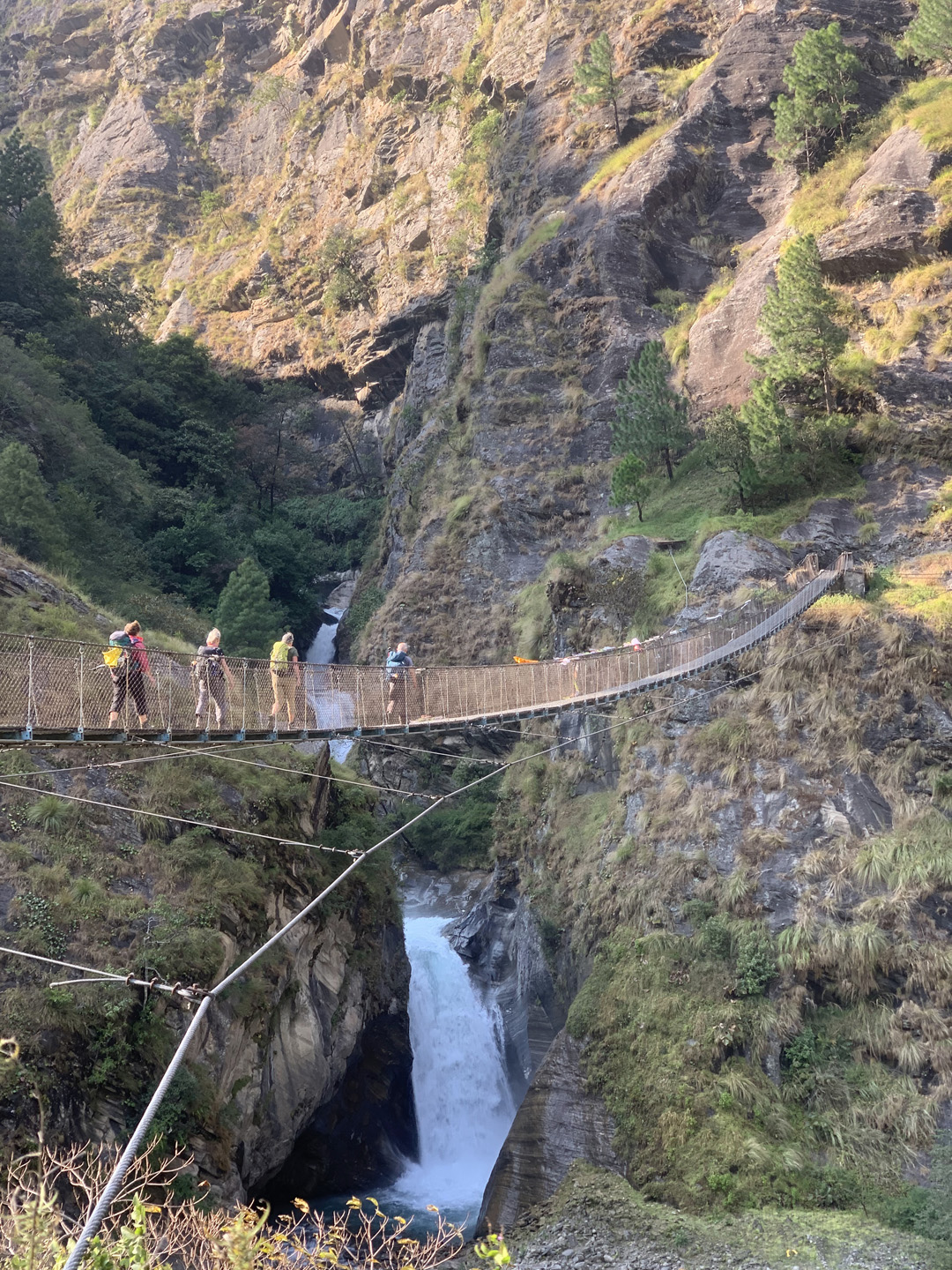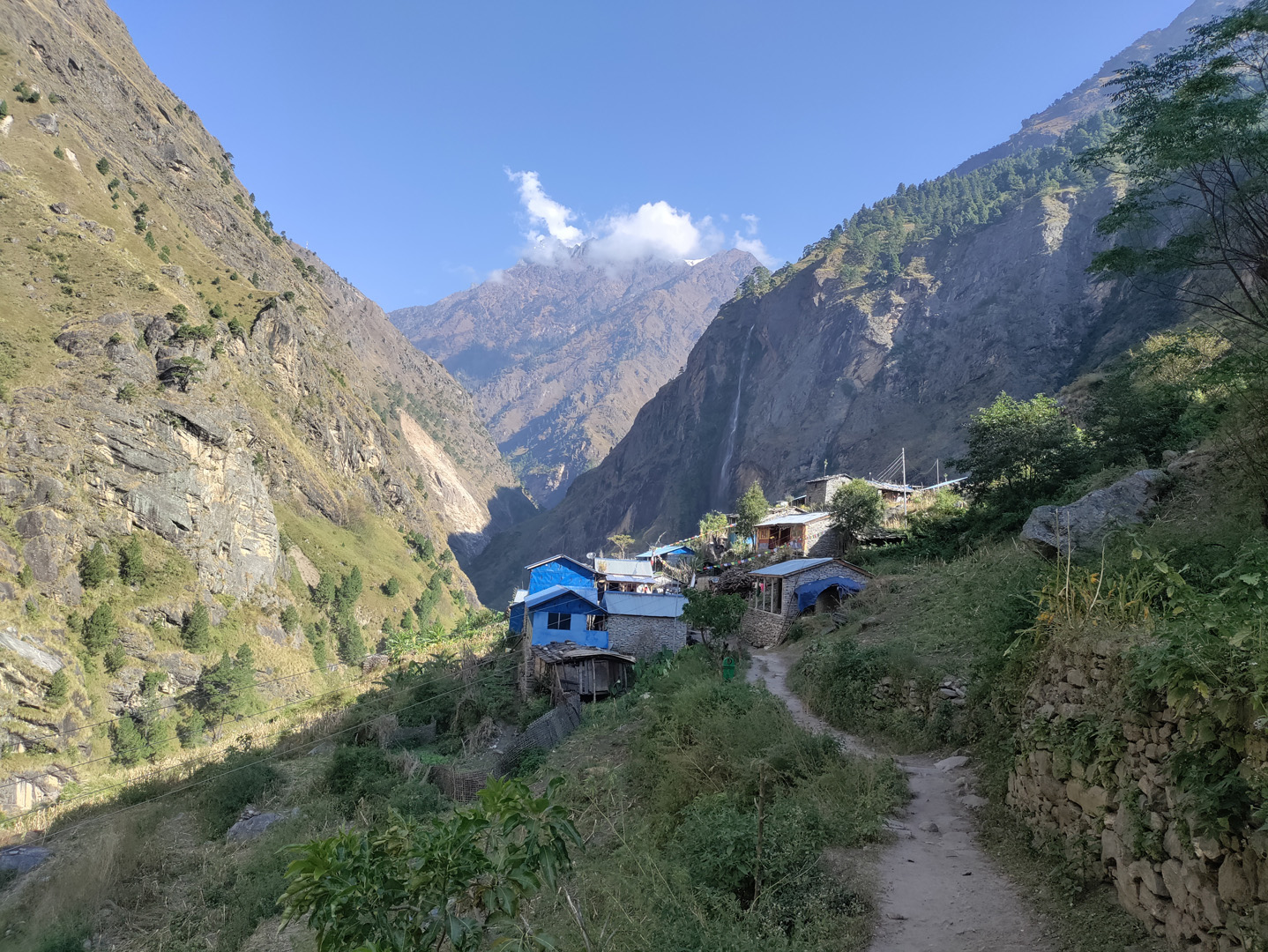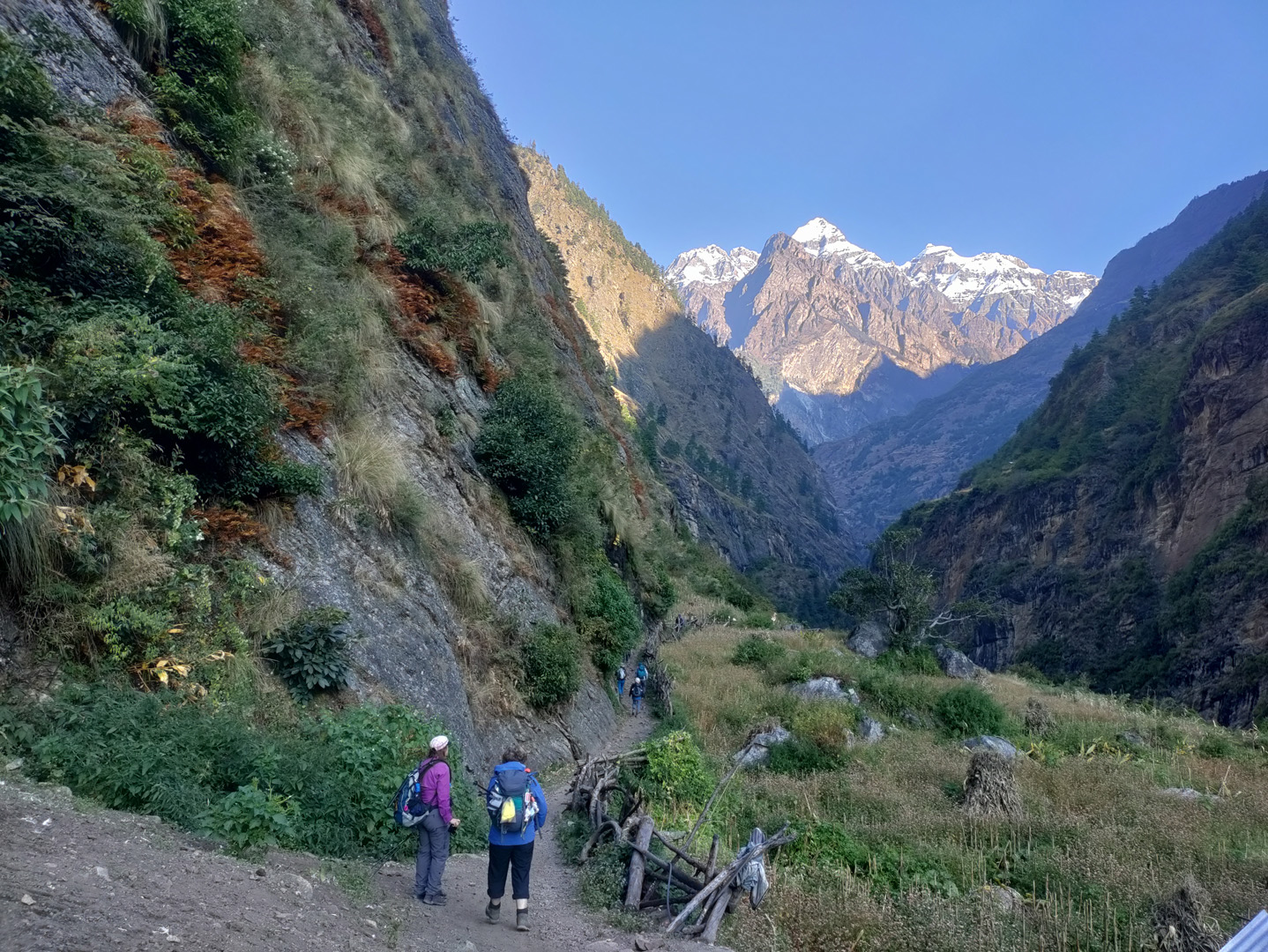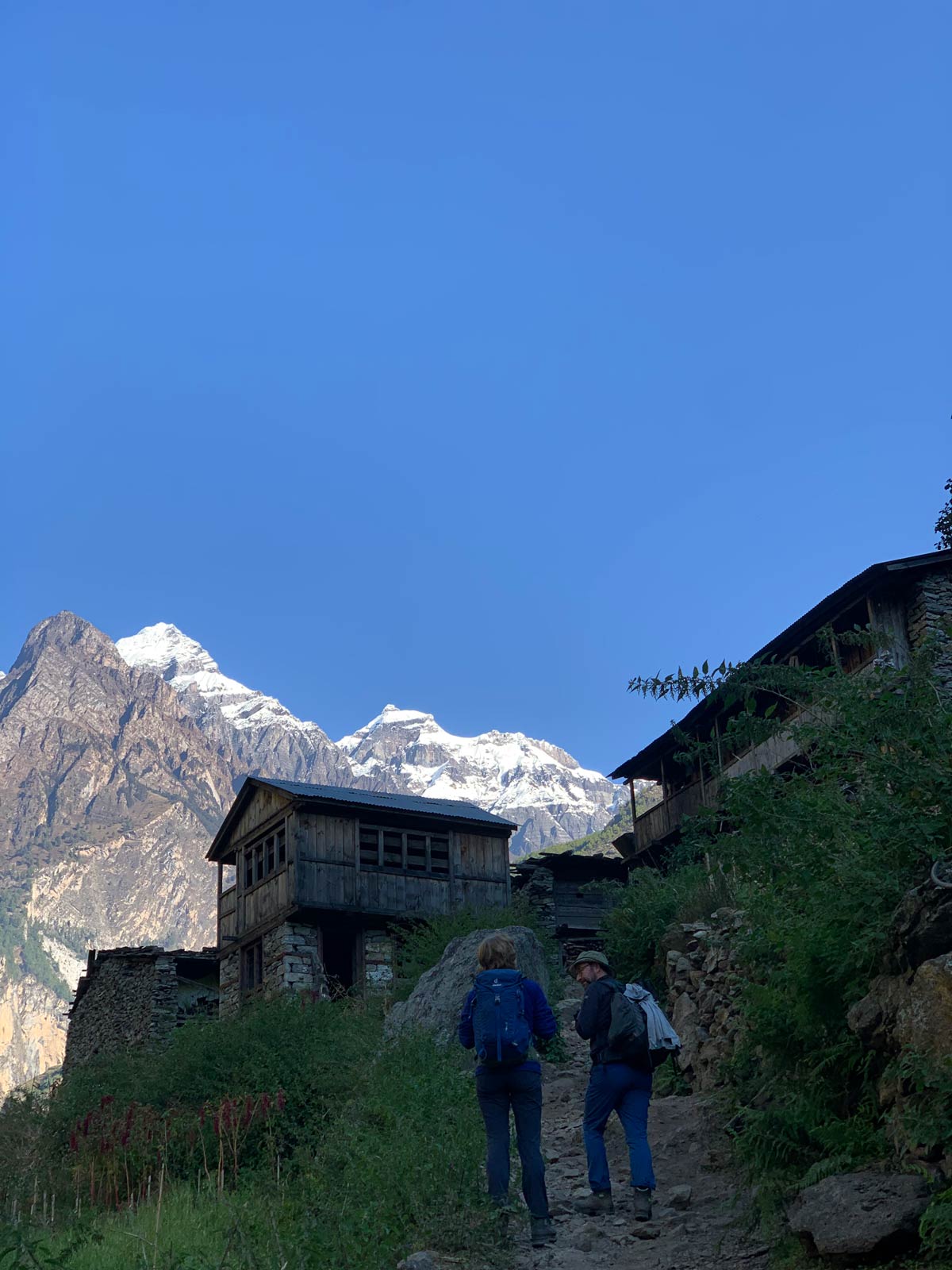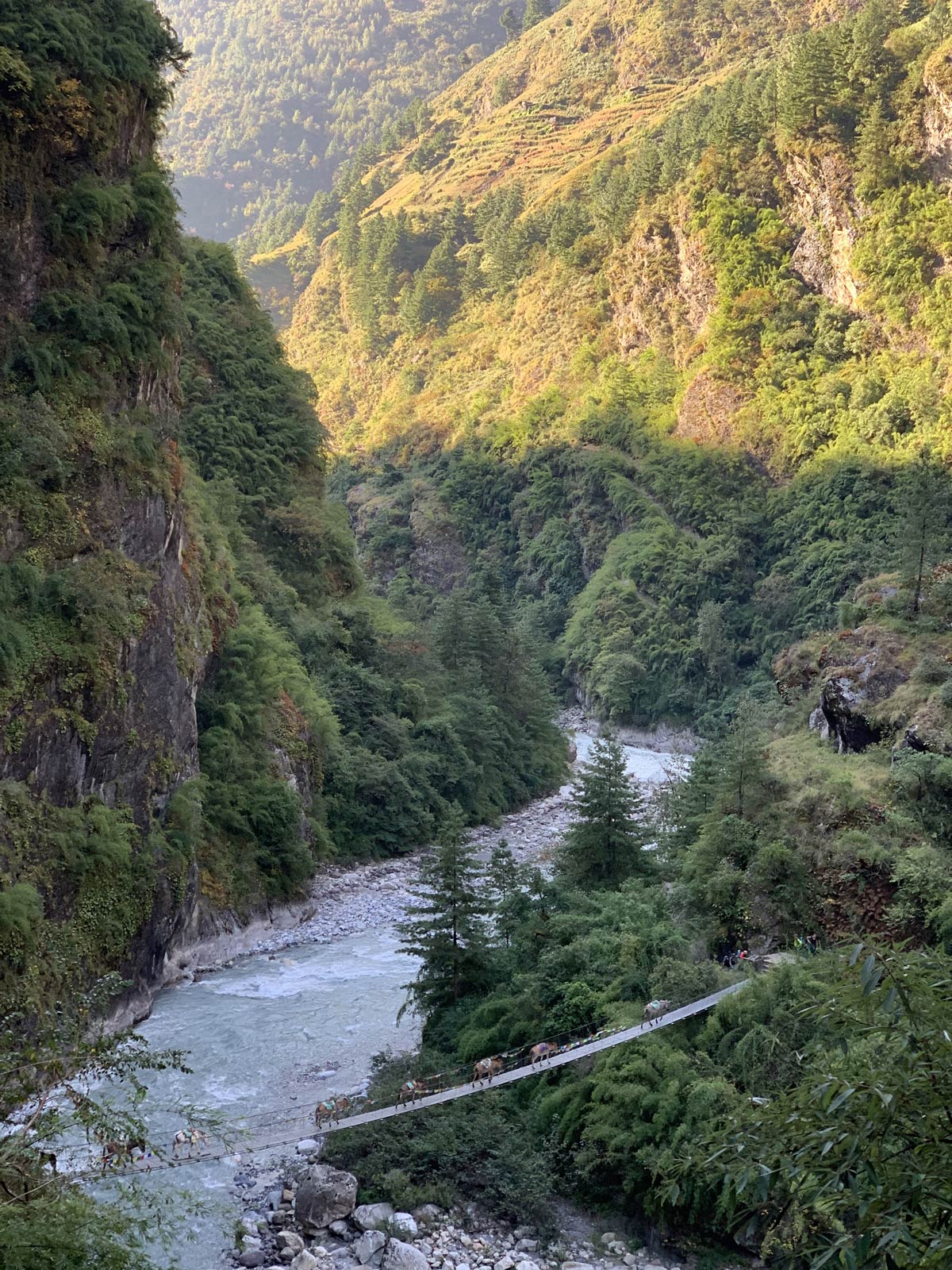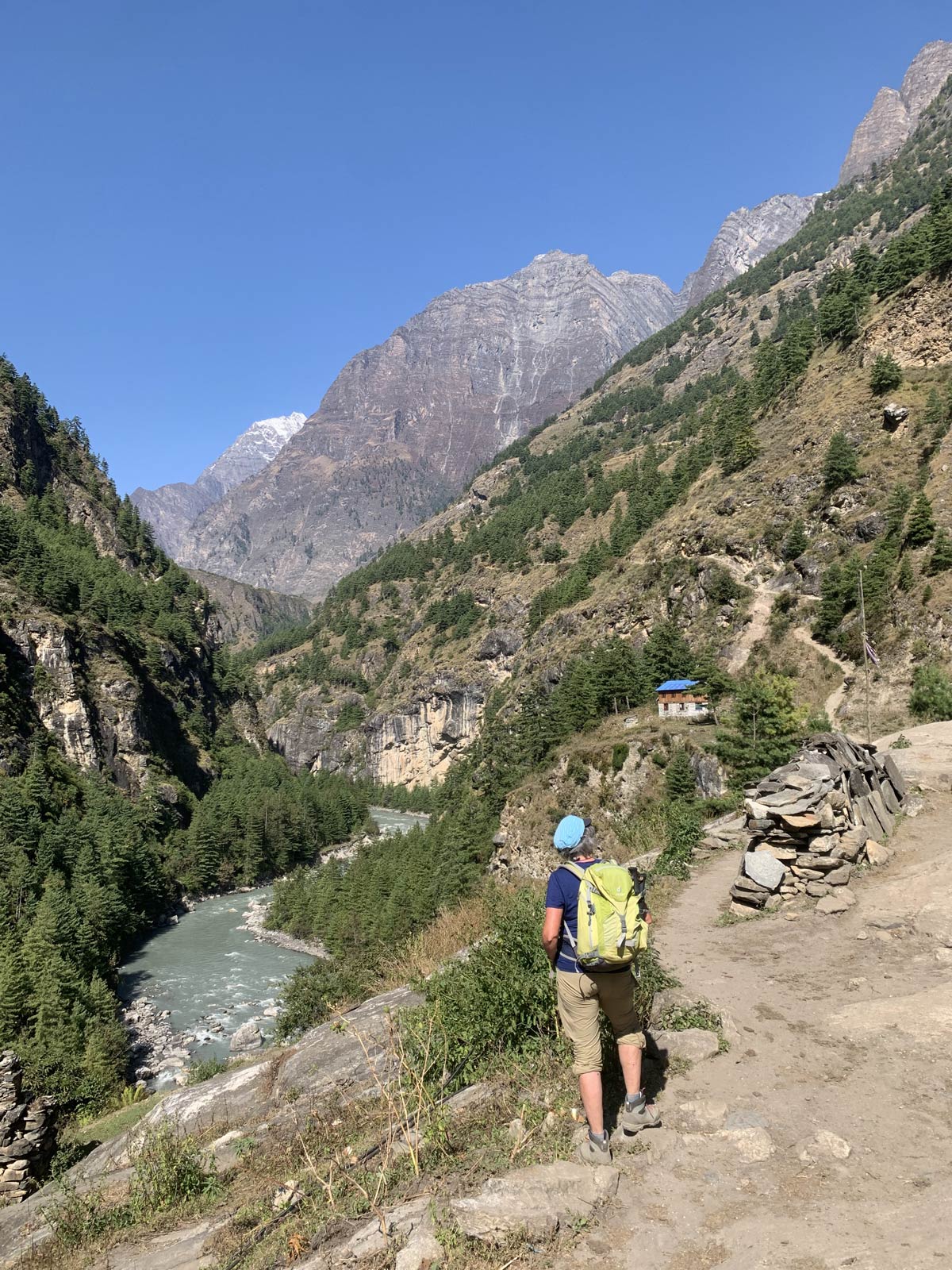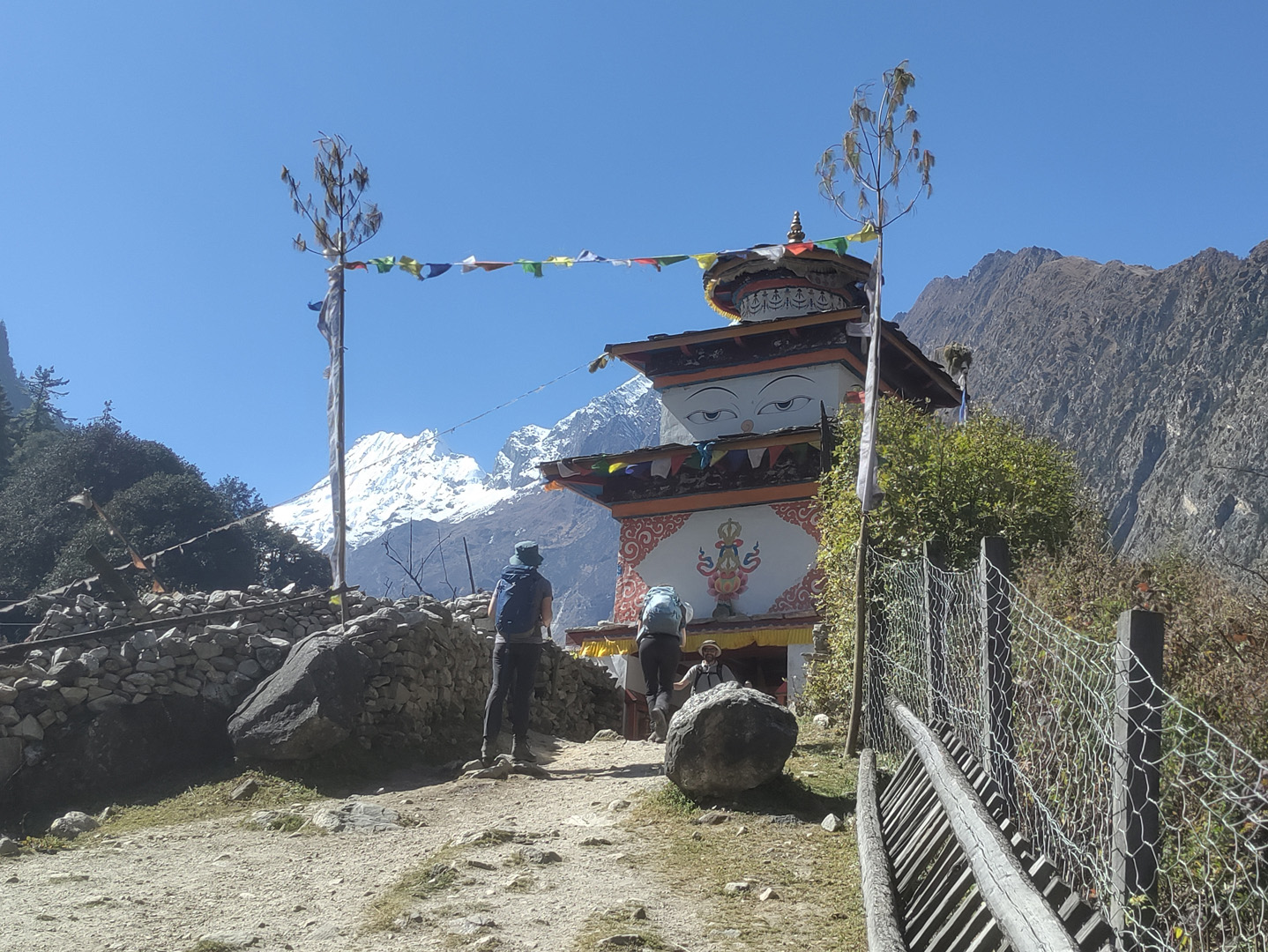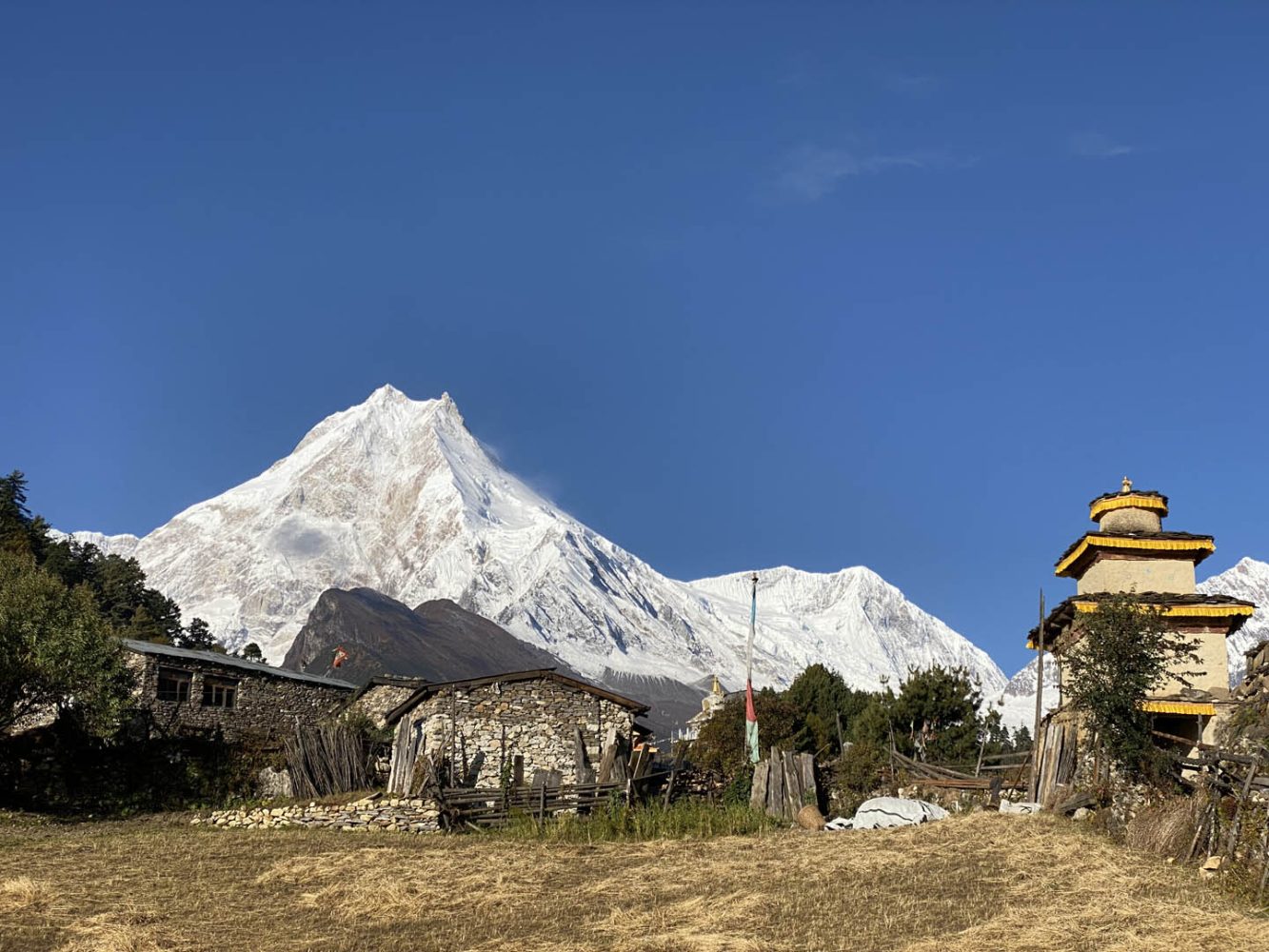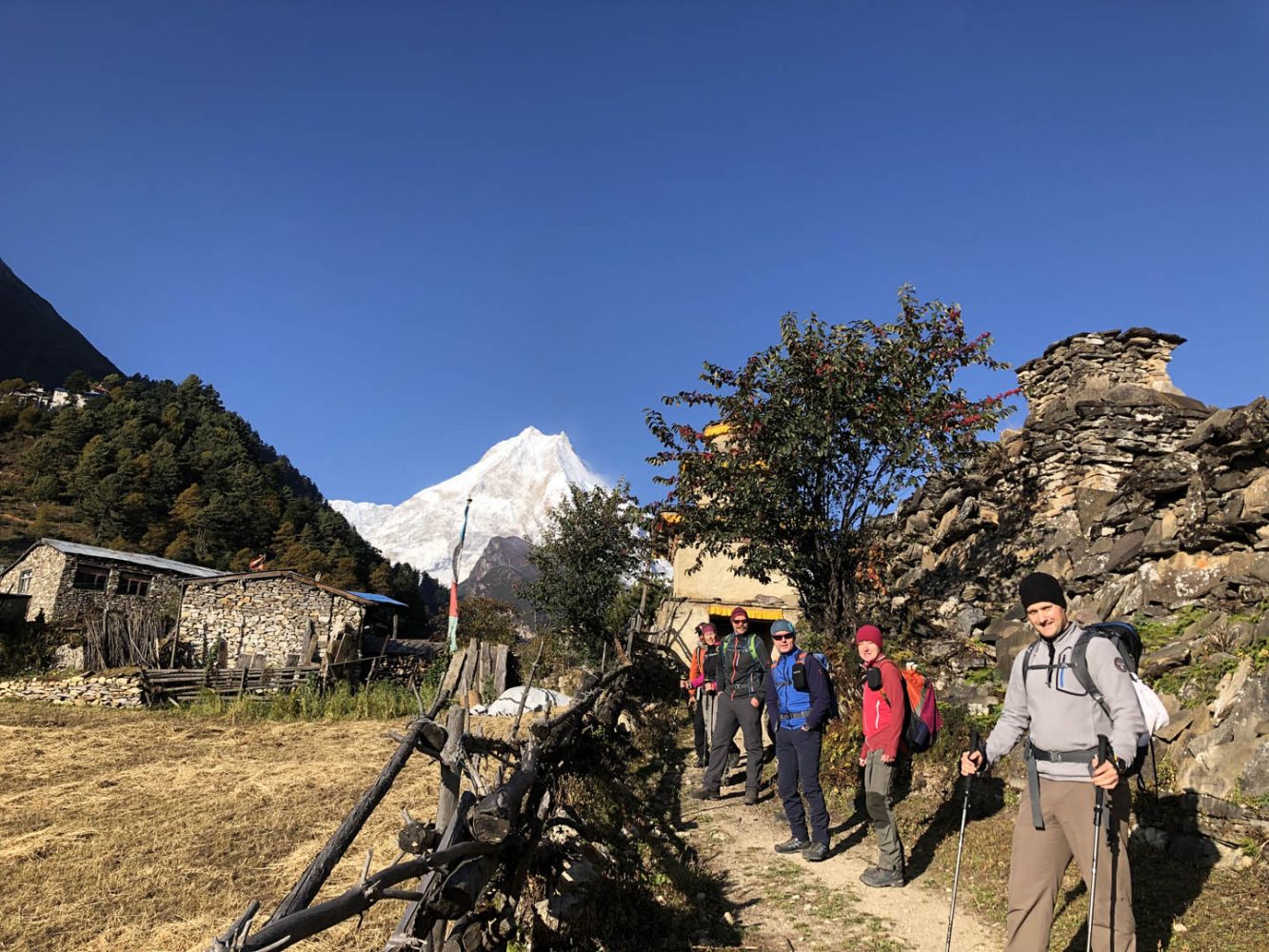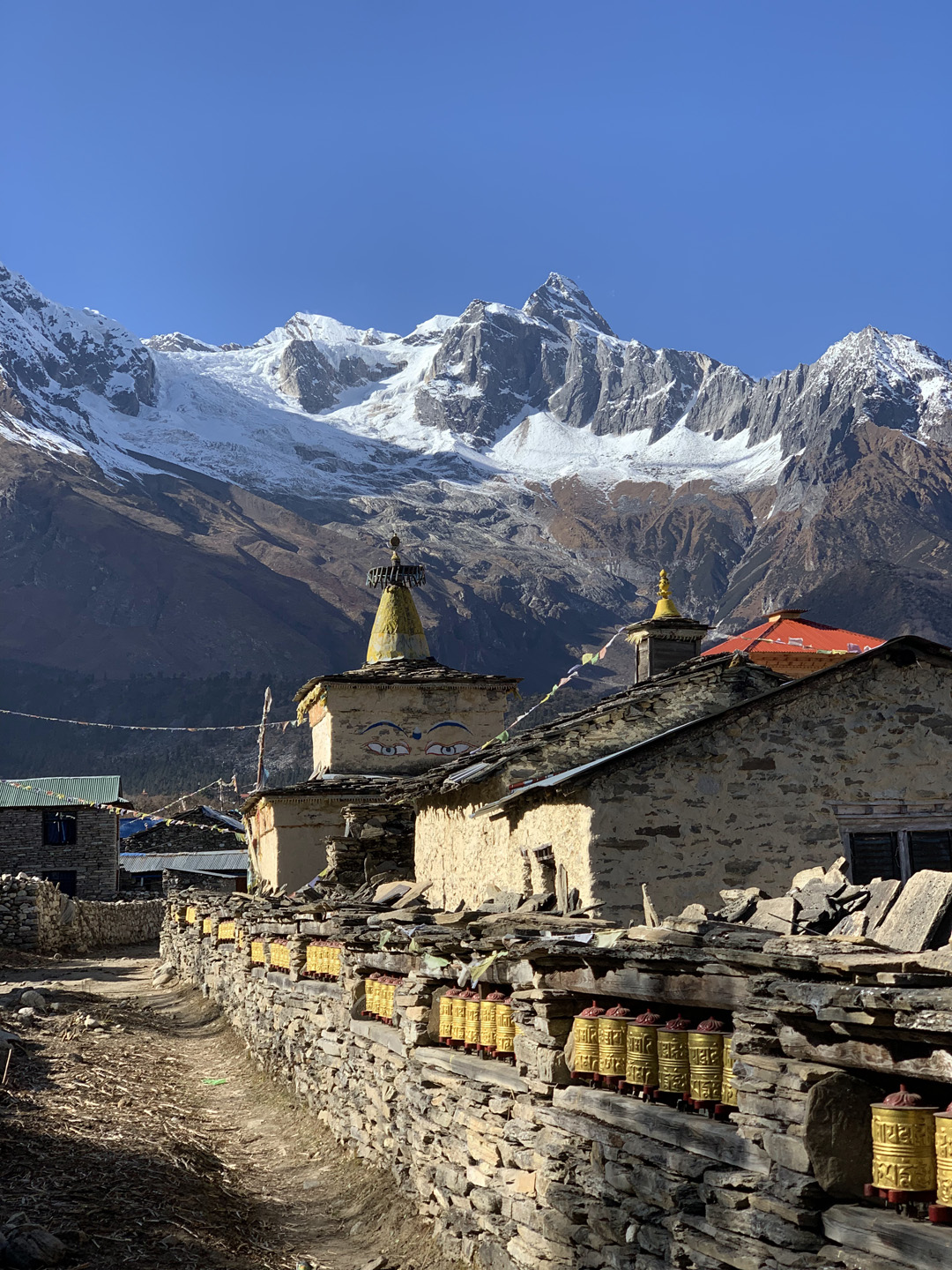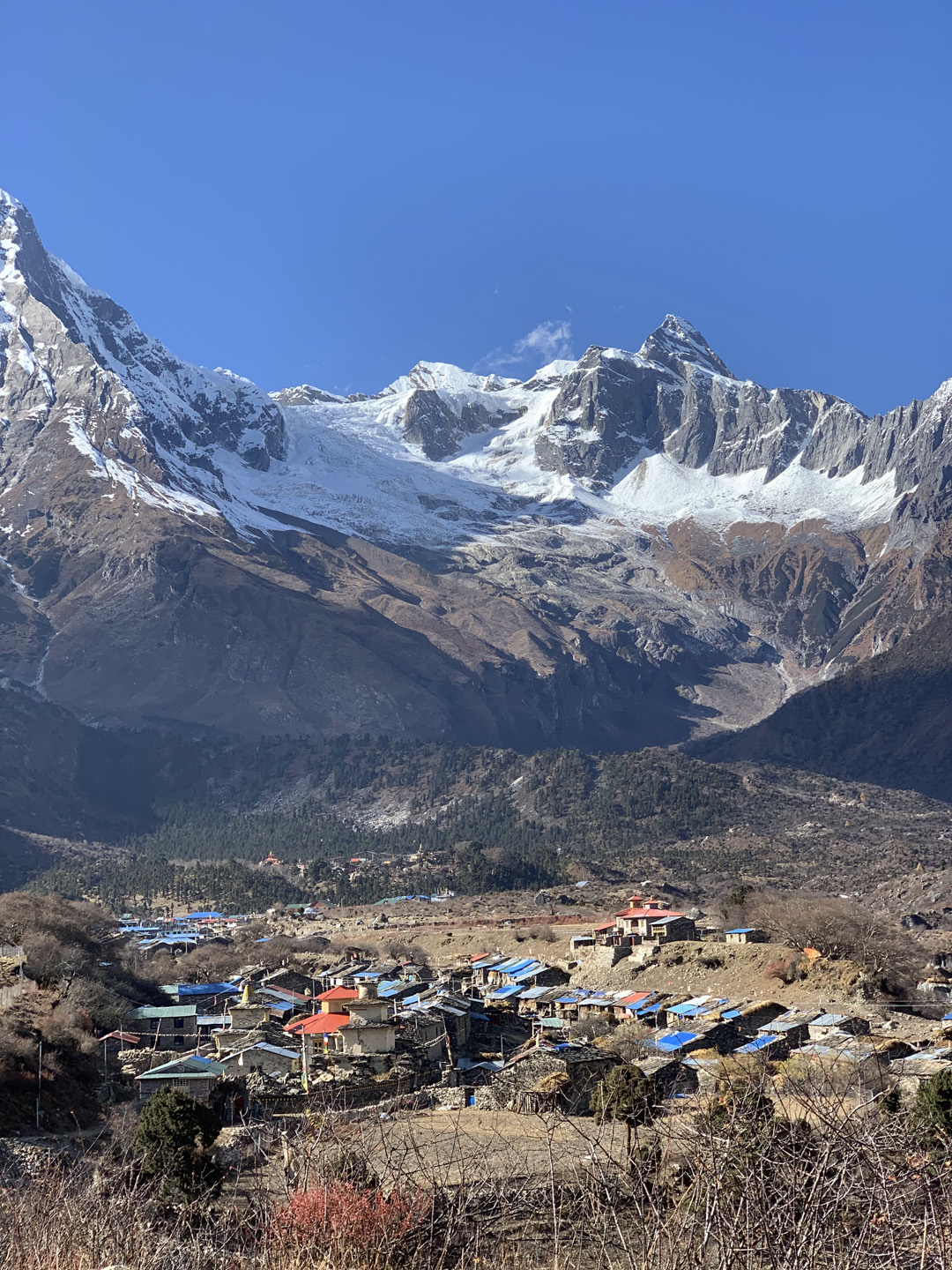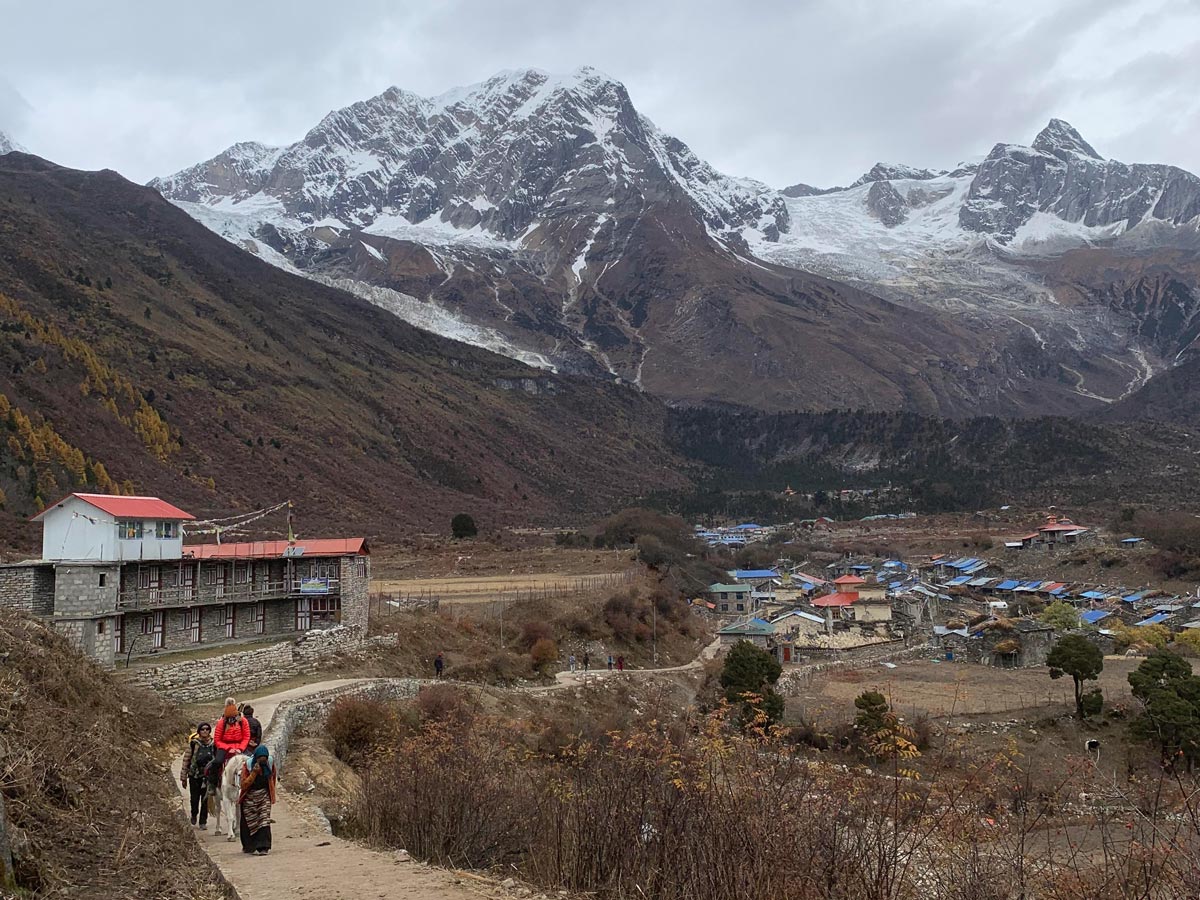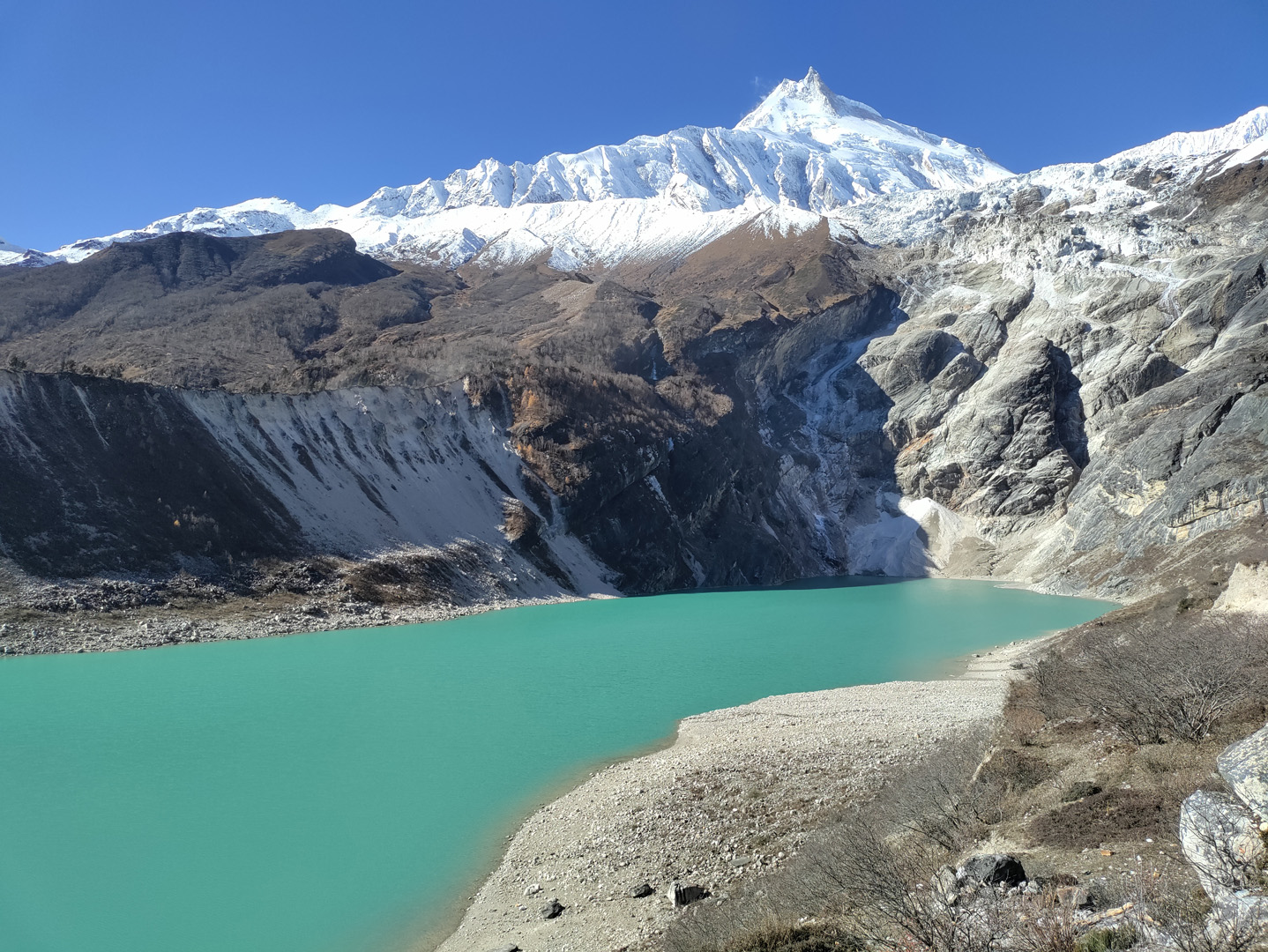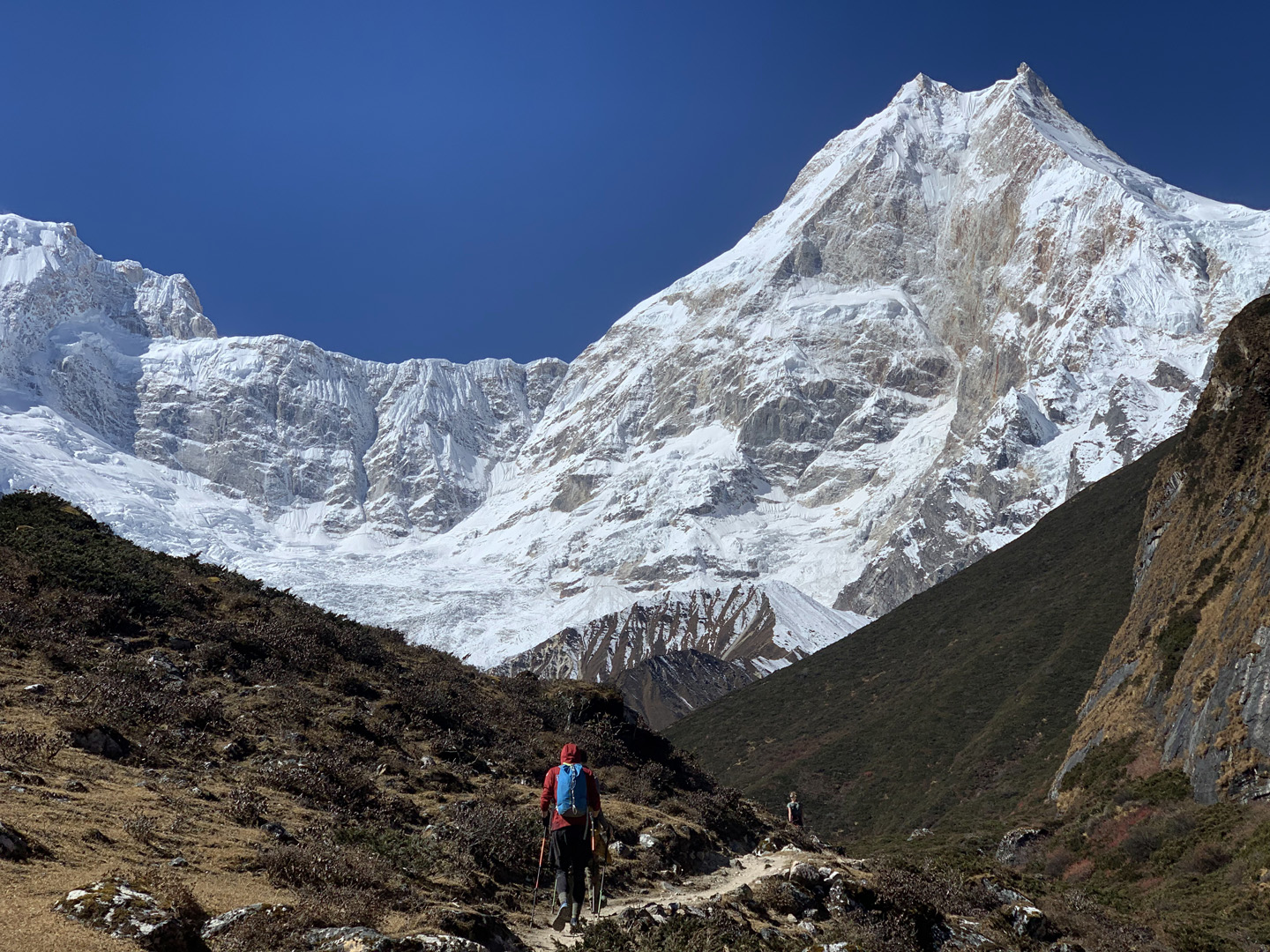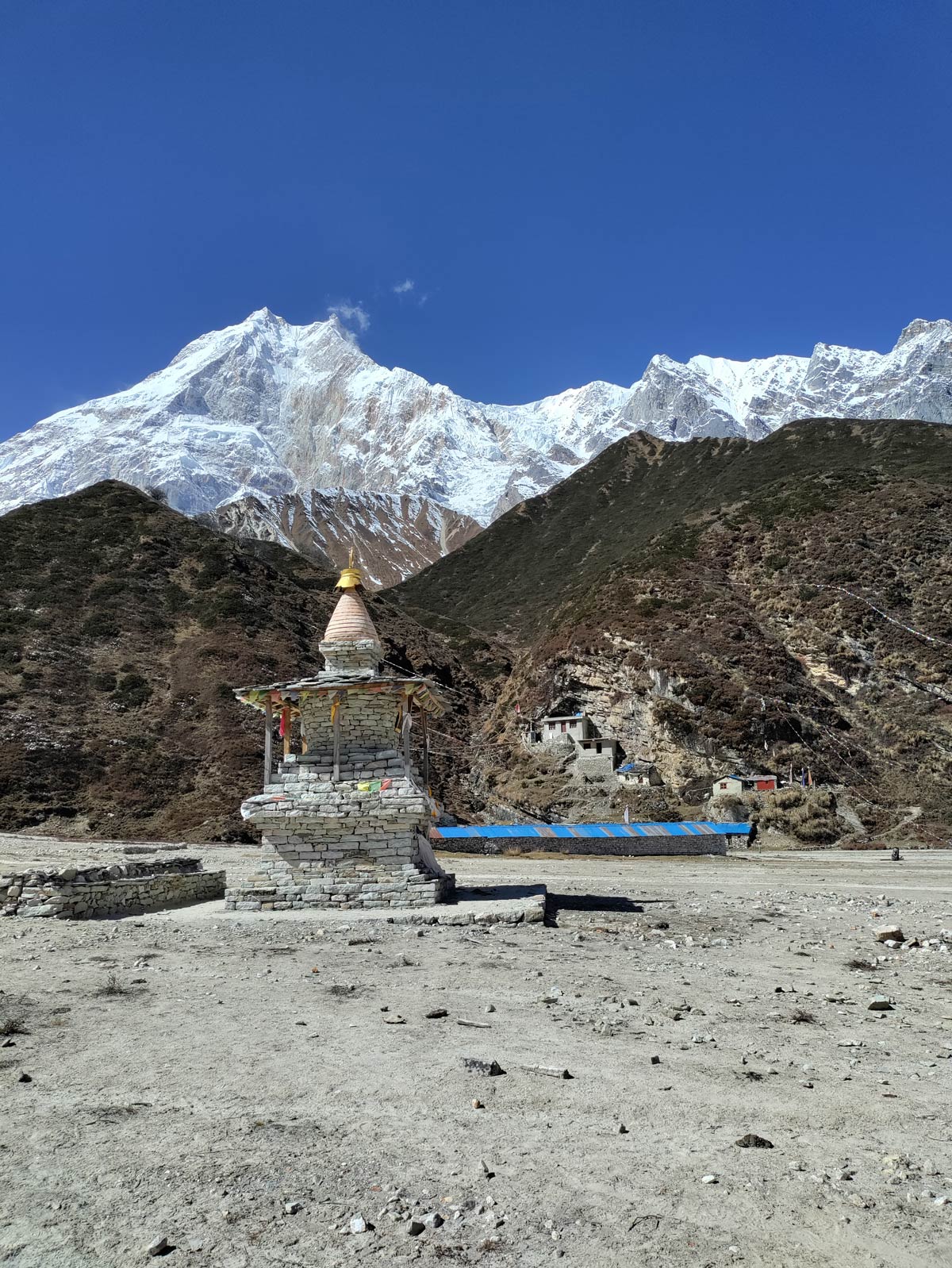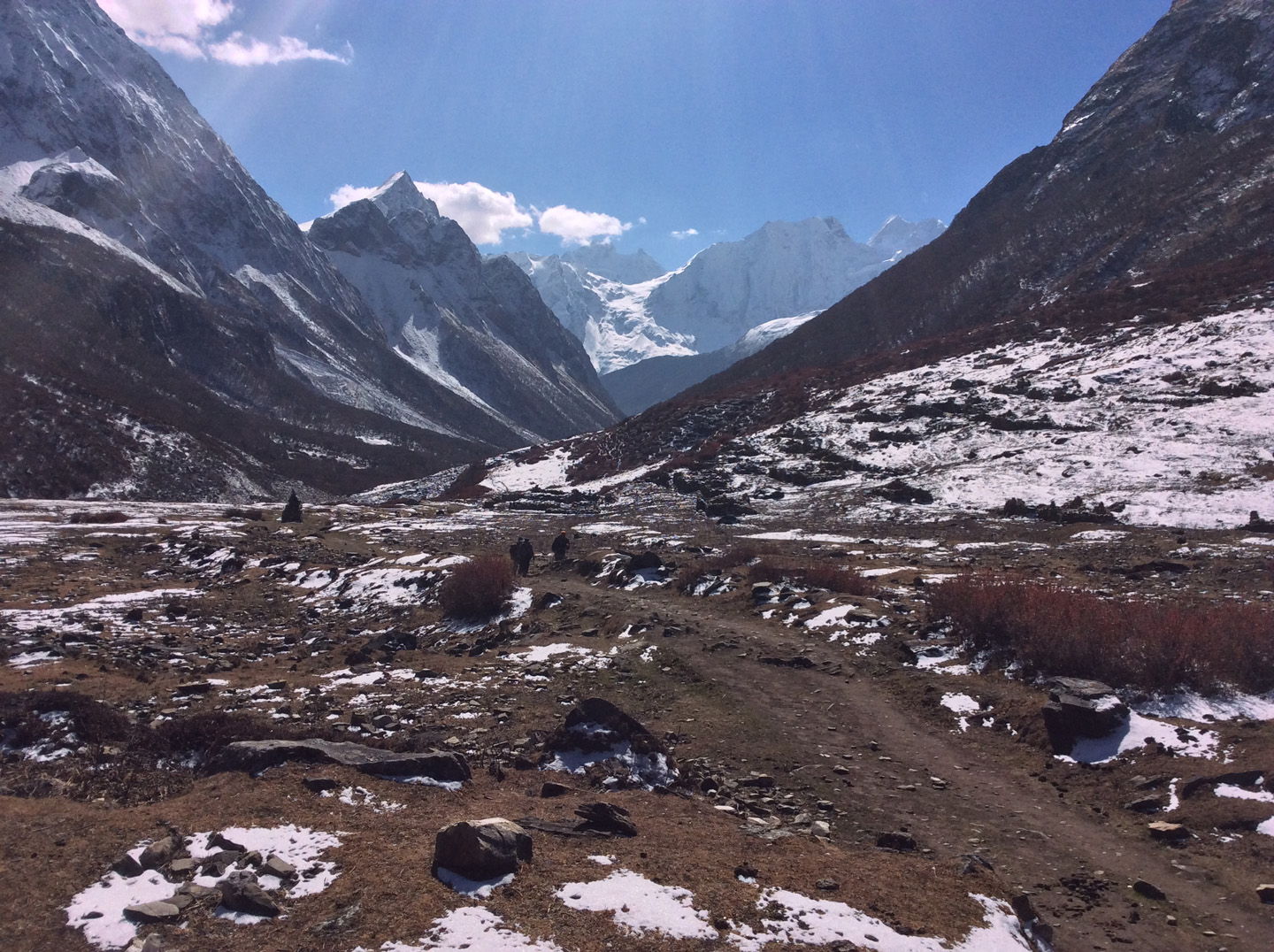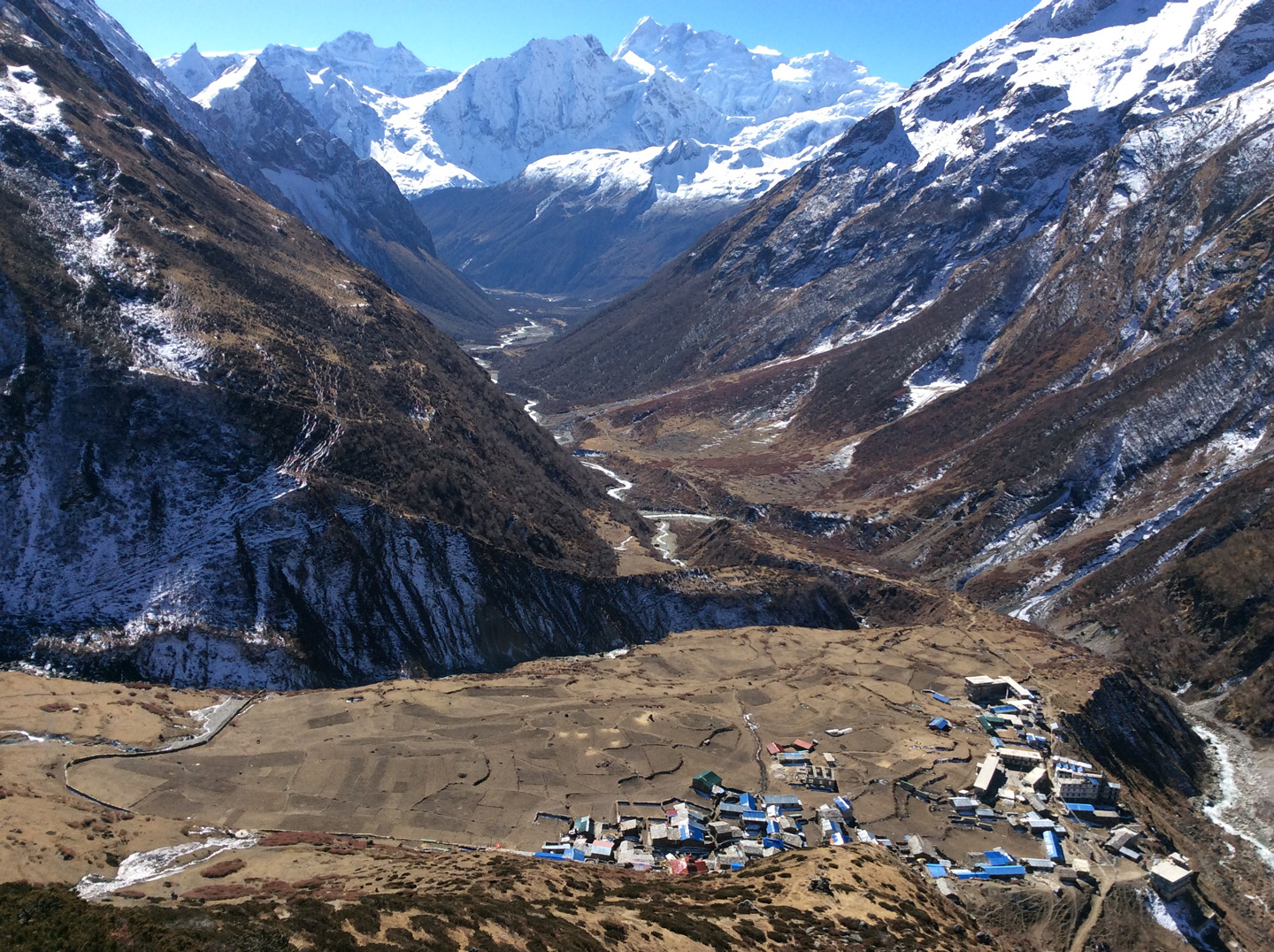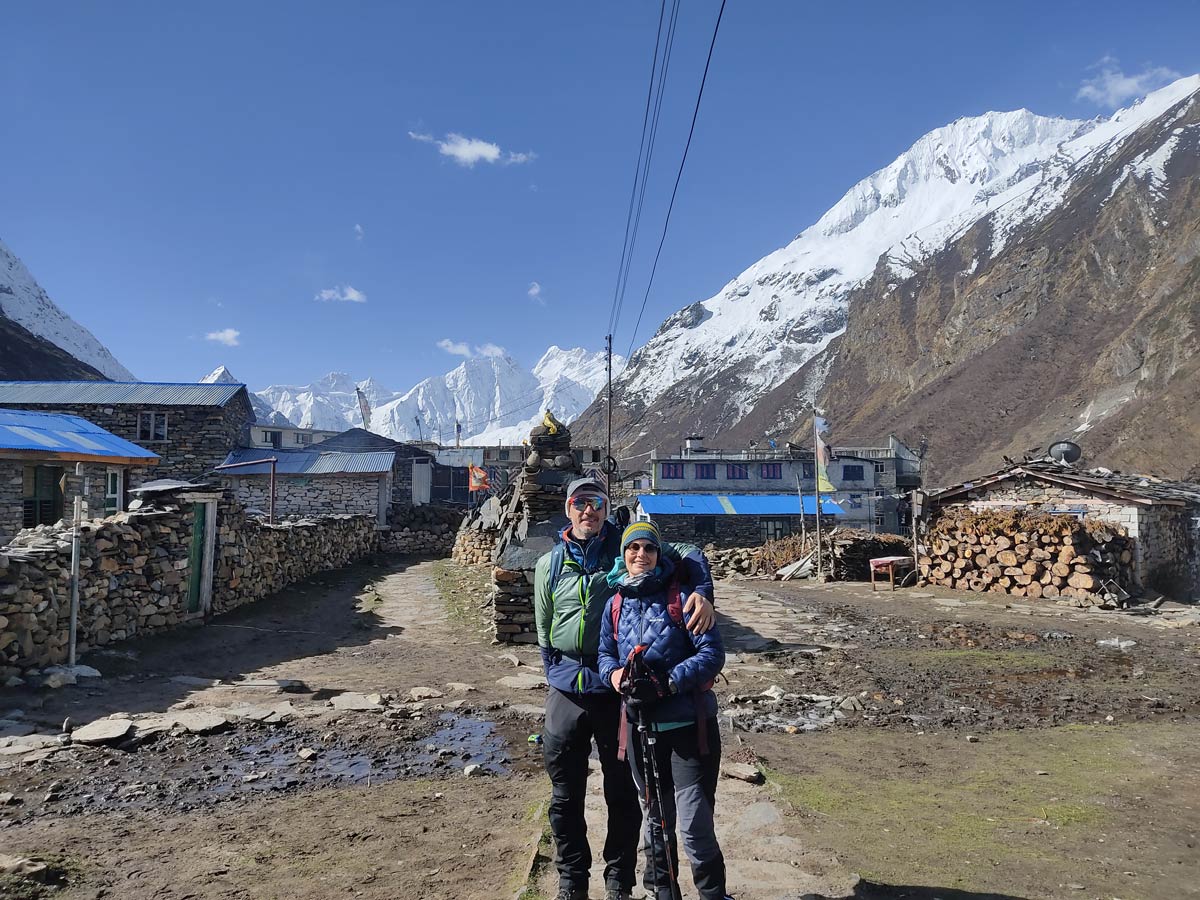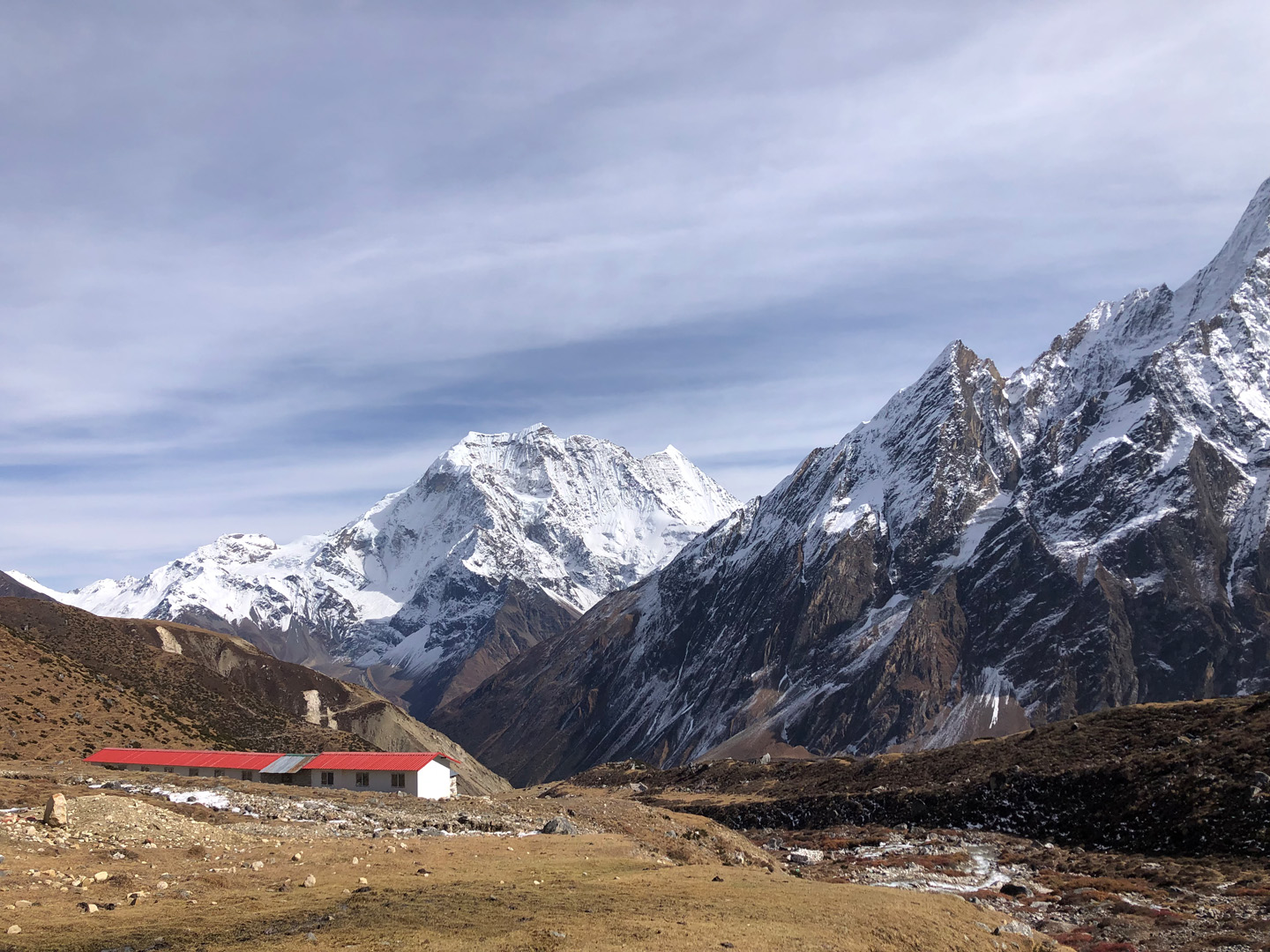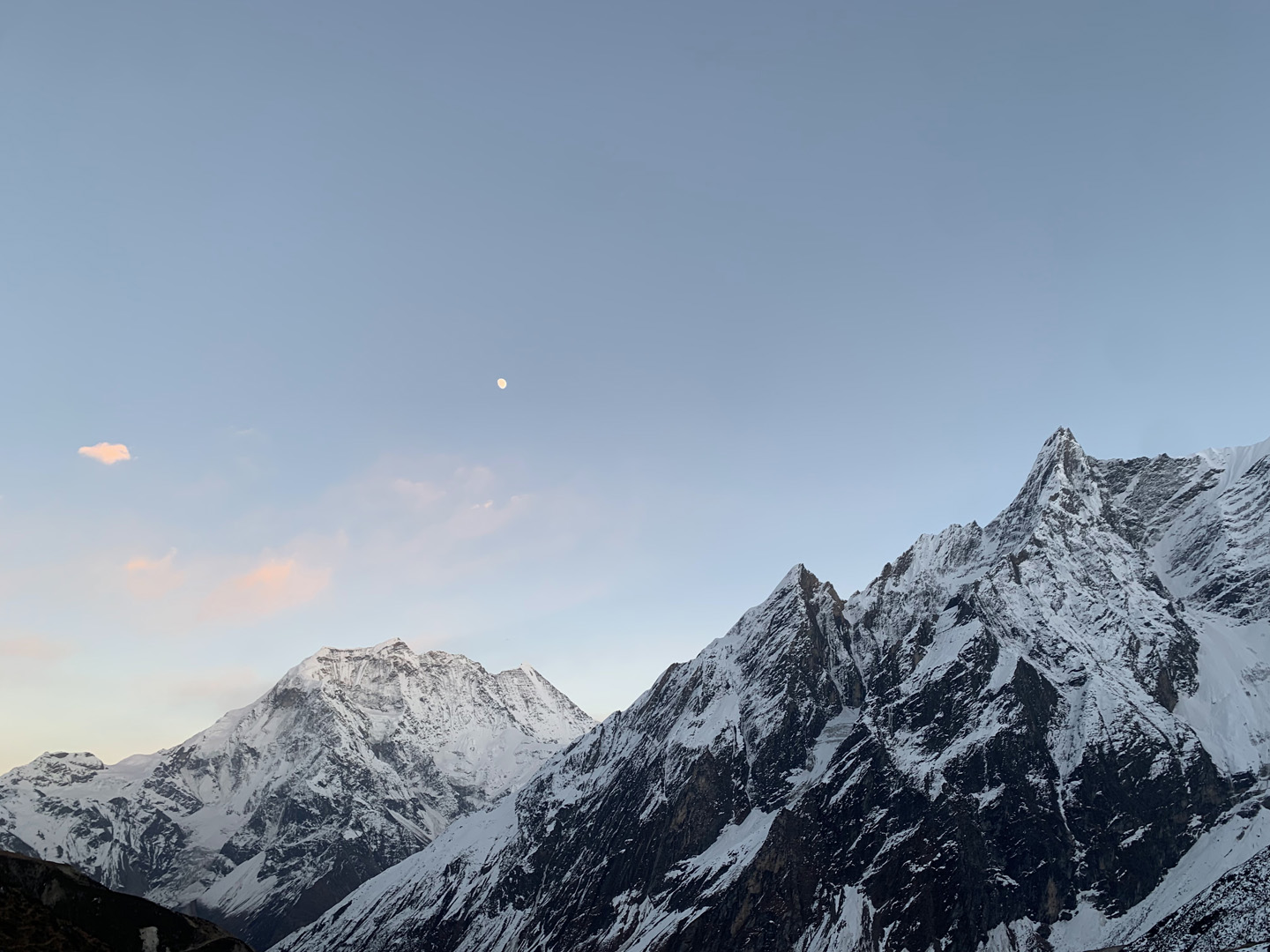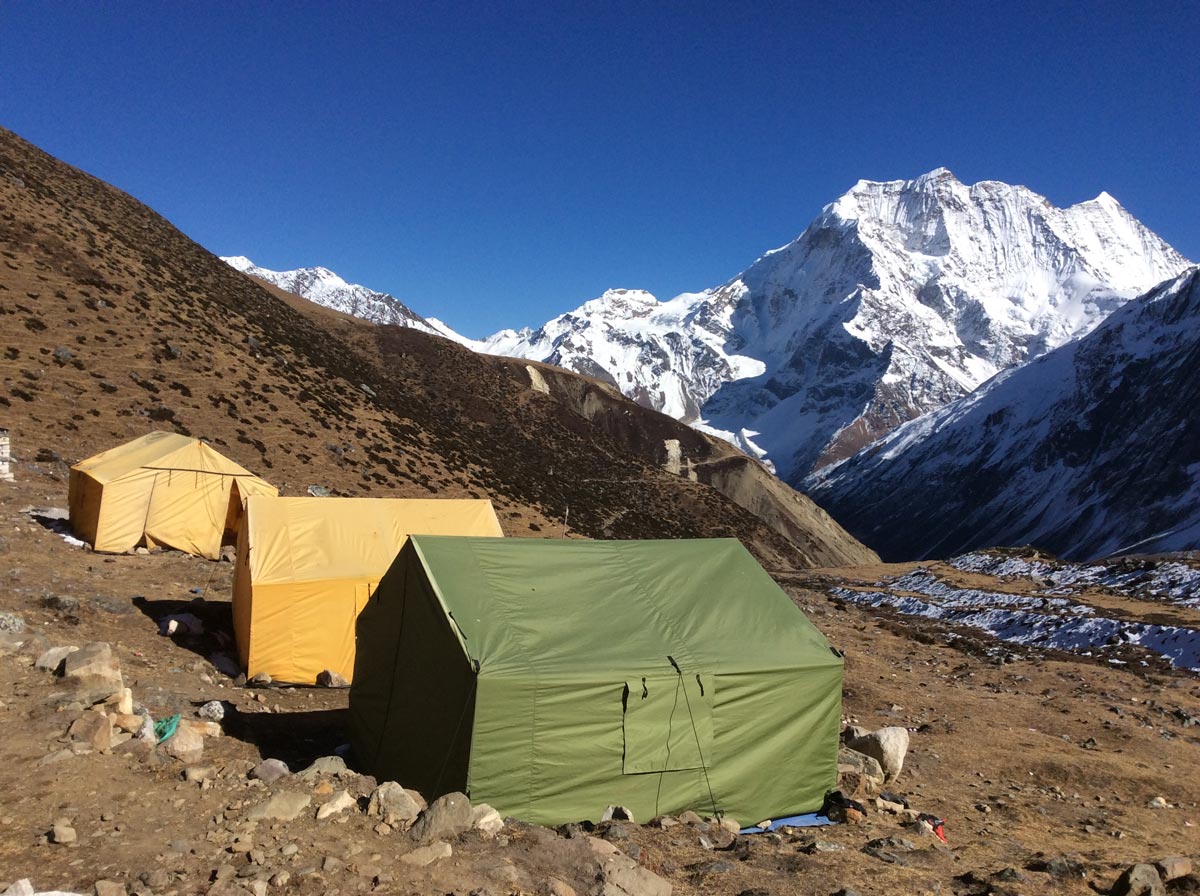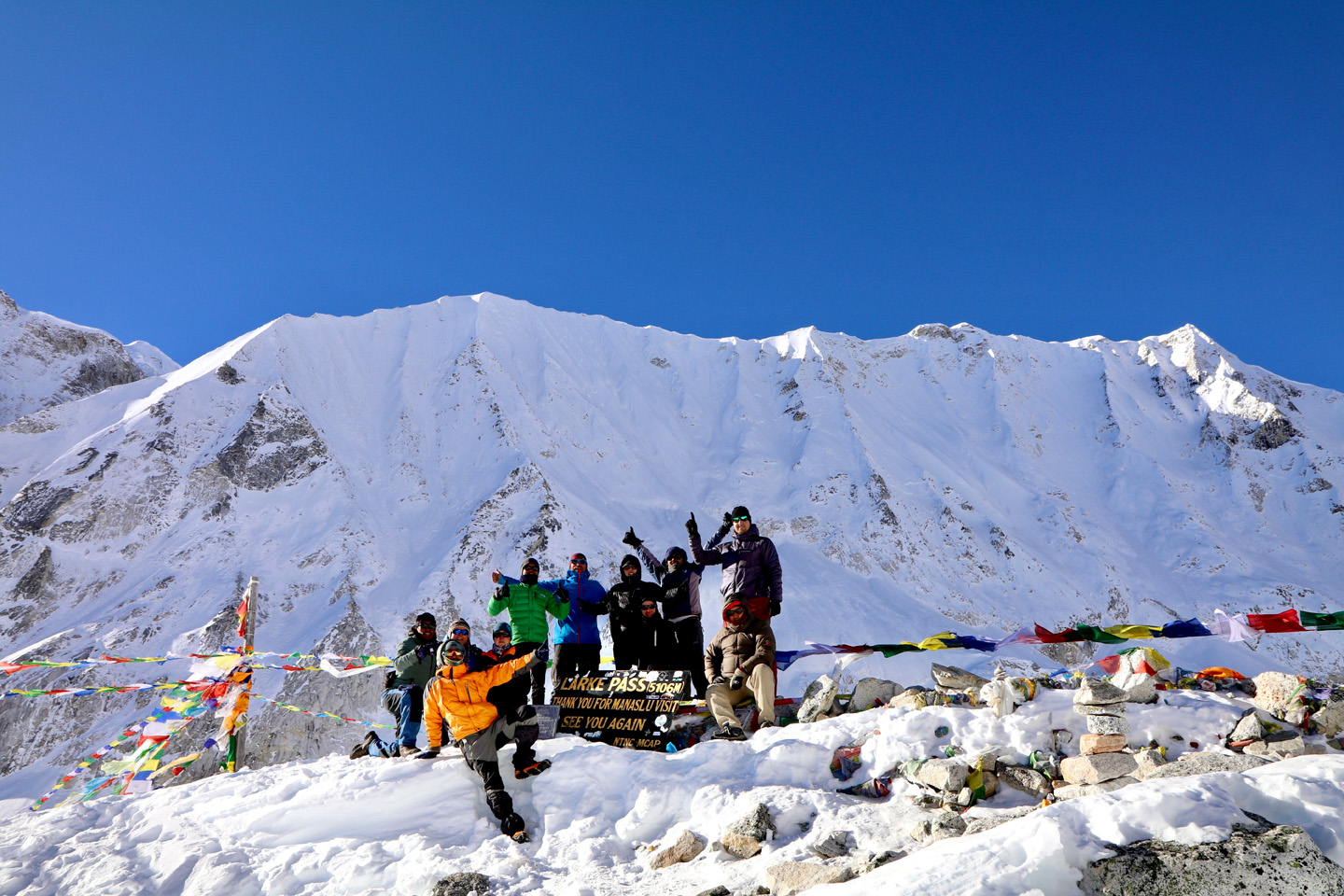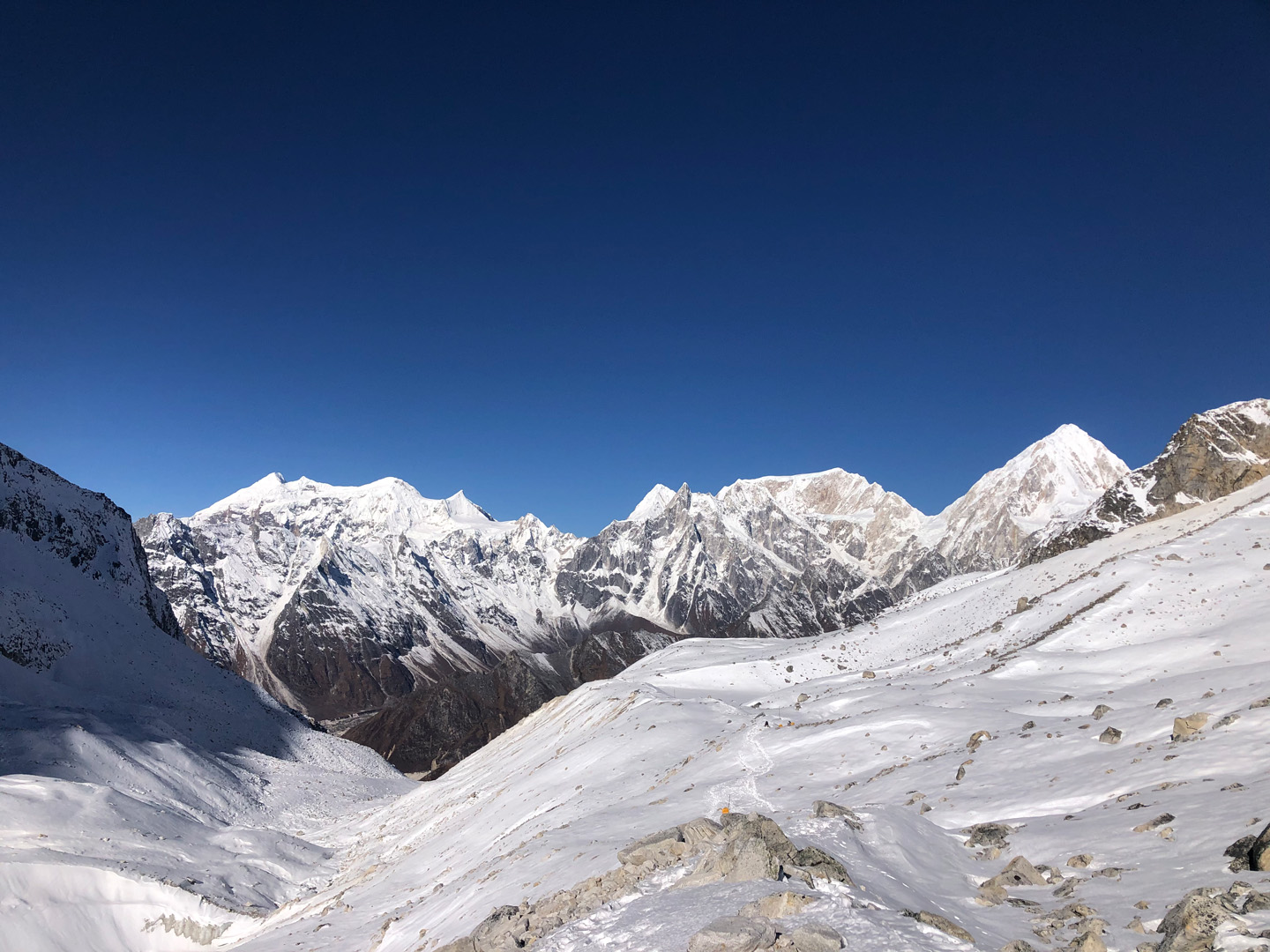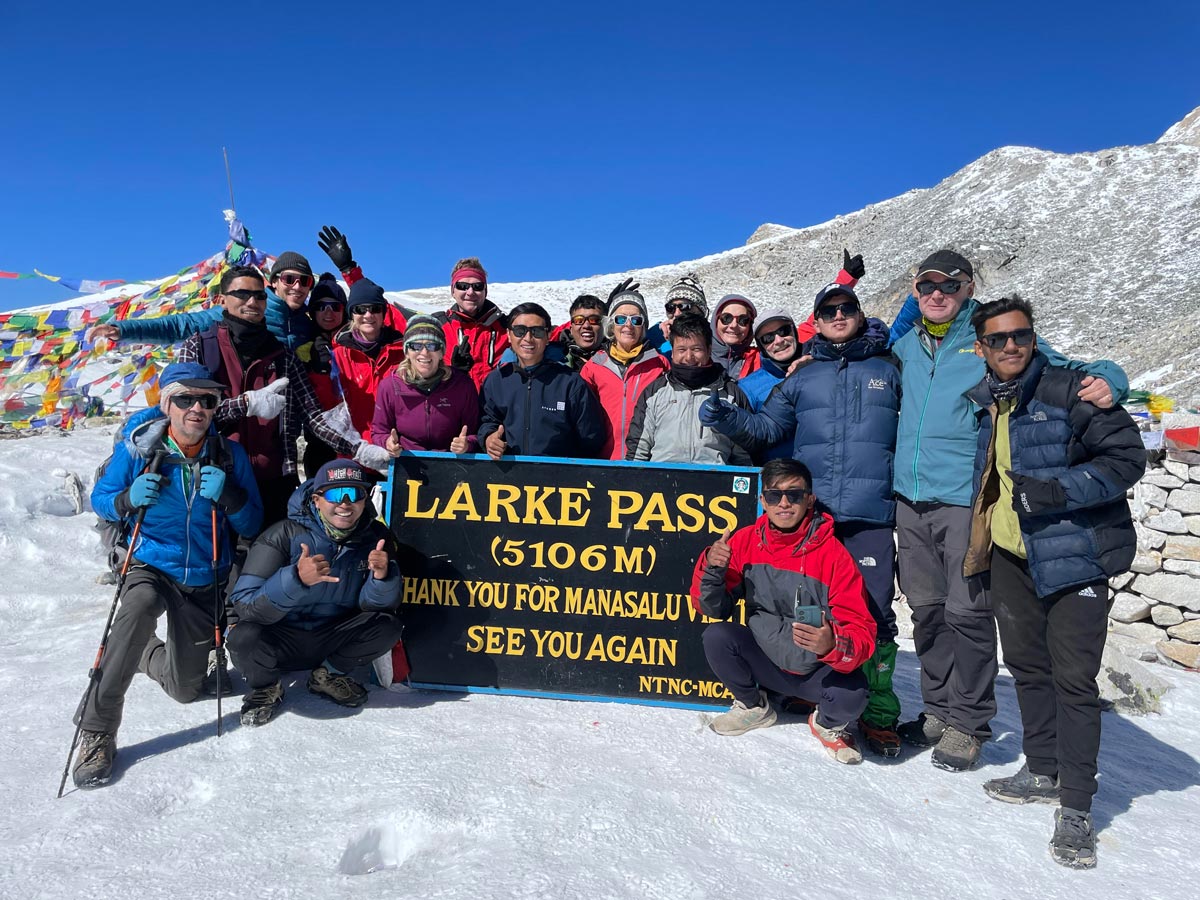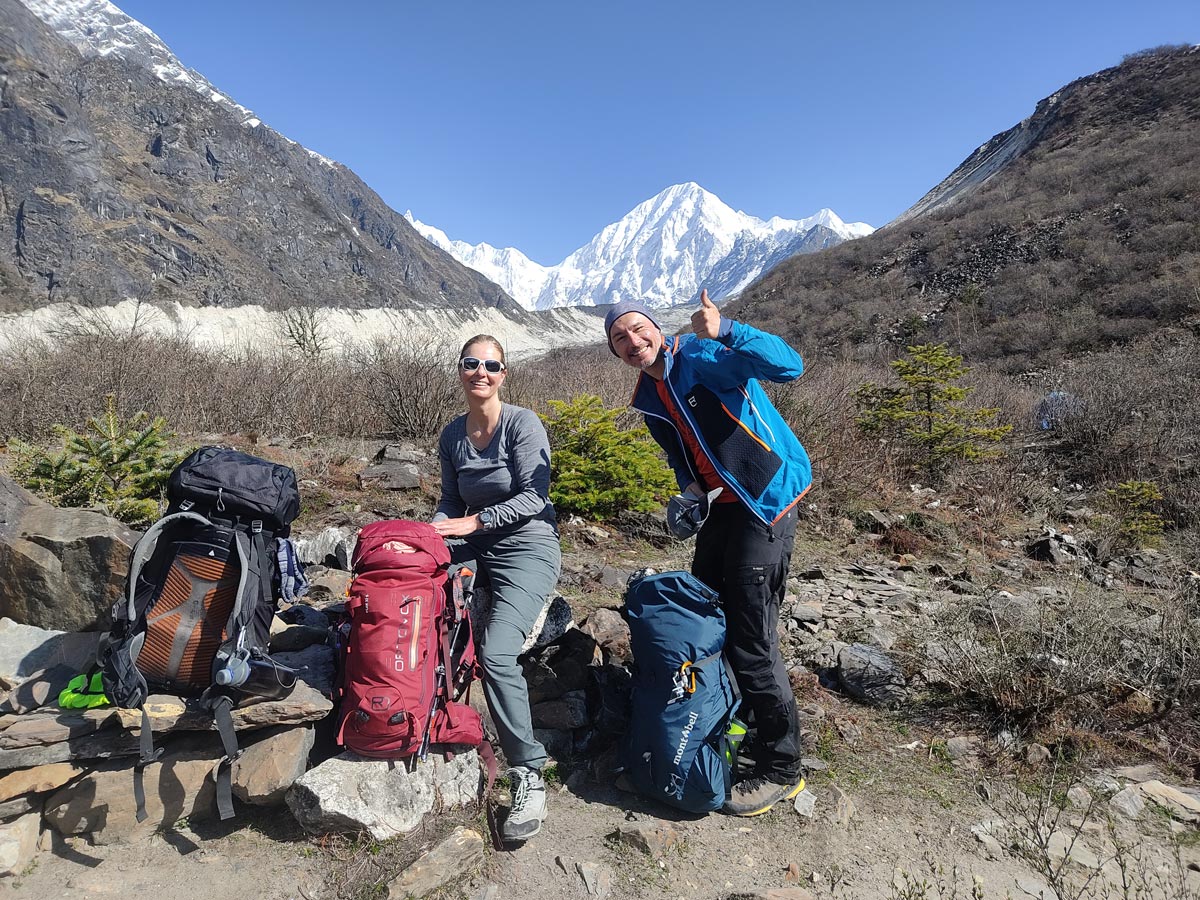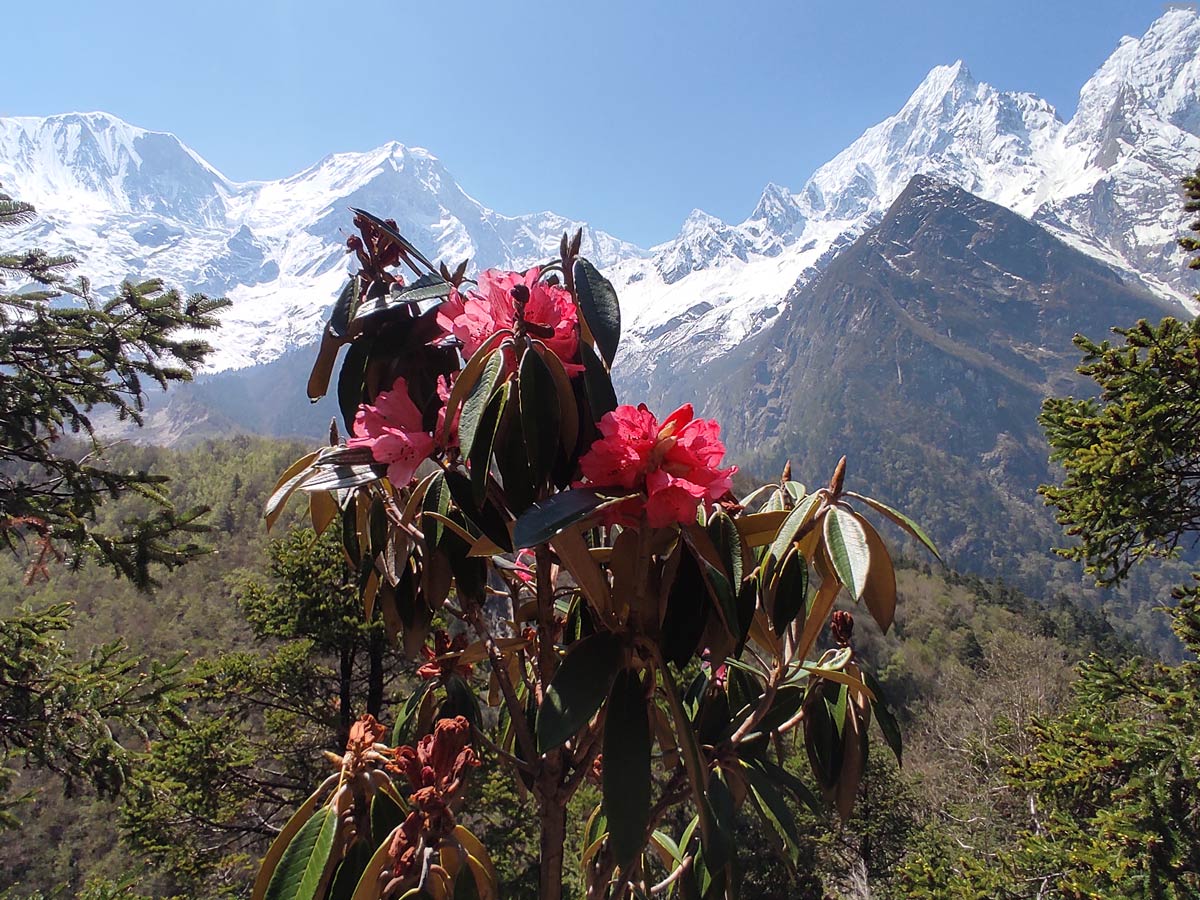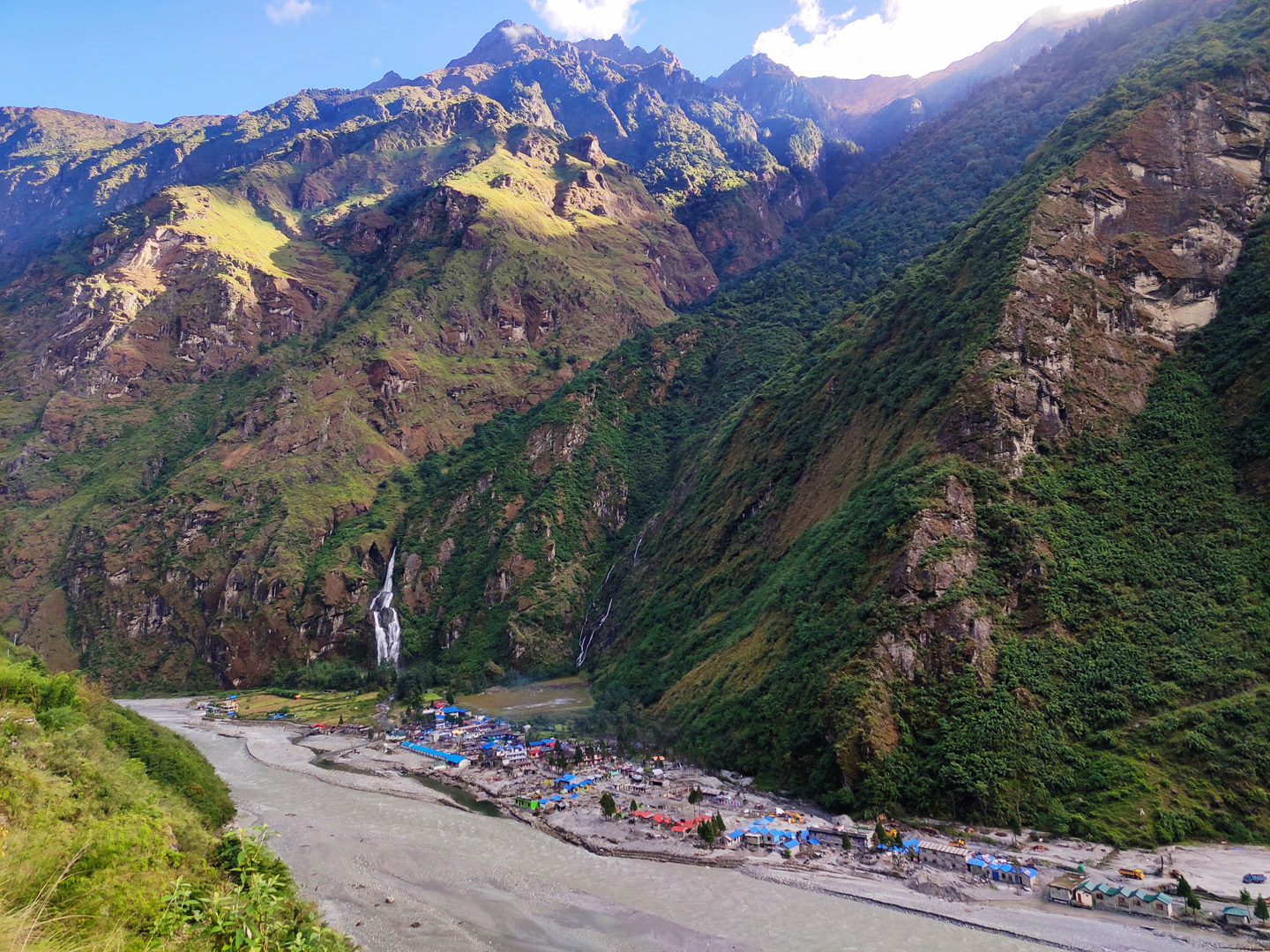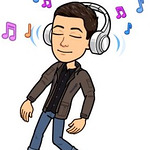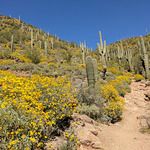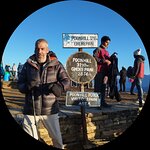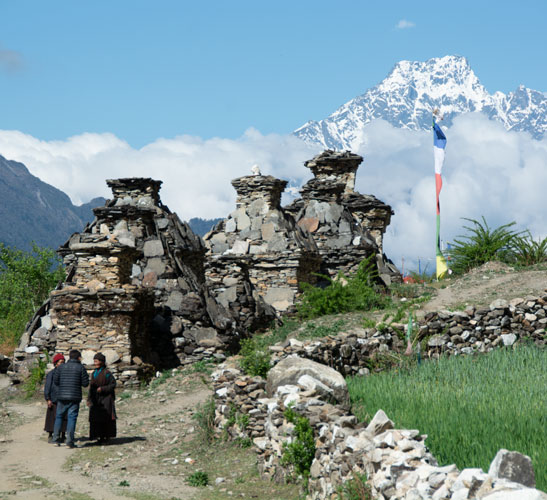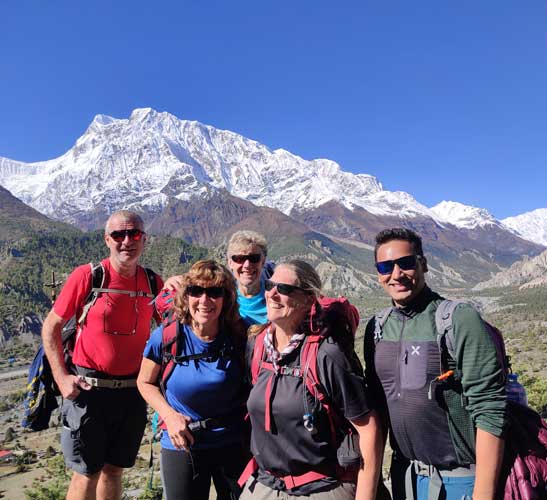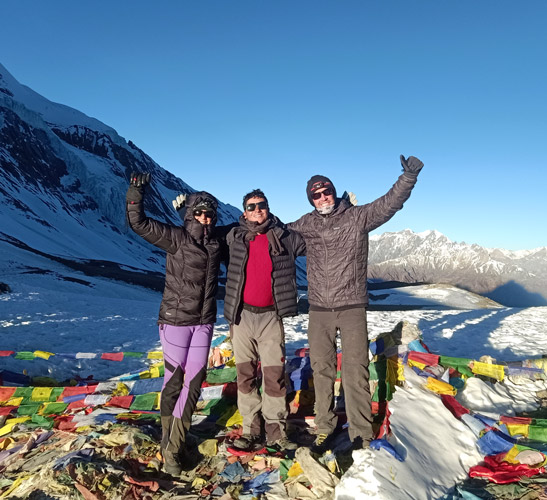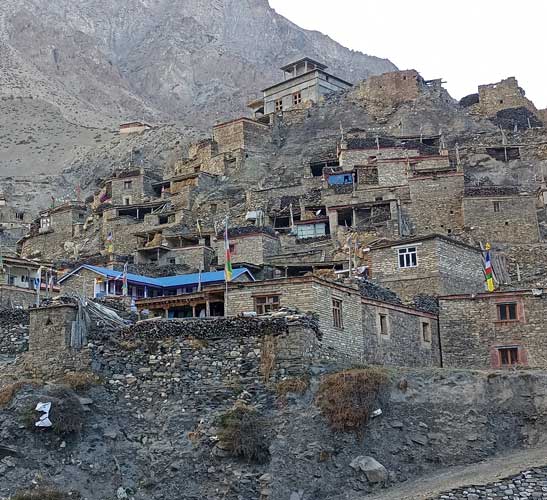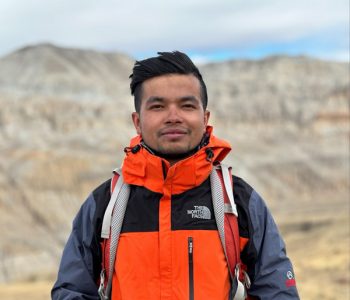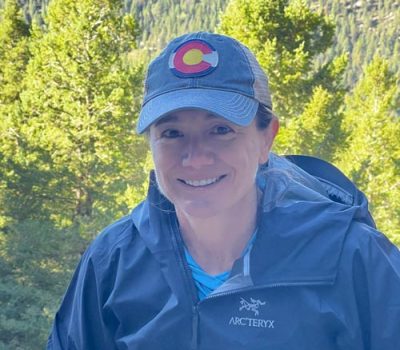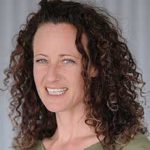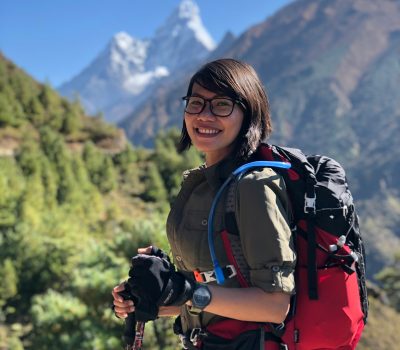Manaslu Circuit Trek - 15 Days
Trek through the reasonably untouched trekking circuit of Nepal; the Manaslu Circuit. Explore the beautiful, least crowded trekking trail and make memories lasting lifetime.
Manaslu Circuit Highlights
- Scenic drive to Machha Khola from Kathmandu.
- Explore the Budhi Gandaki River valley.
- Experience the Nepalese and Tibetan mixture of culture.
- Walking between the borders of Nepal and Tibet.
- Crossing Larkya La over 5,215 m.
Manaslu Circuit Trek Overview
Exploring the untouched region of Nepal, the Manaslu Circuit trek is emerging to be one of the most extraordinary trekking experiences in the country. Nestled in the heart of Gorkha, this trek provides you with breathtaking panoramic Himalayan vistas of Mount Manaslu and surrounding peaks.
A perfect synergy of stunning landscapes, cross-cultural exchanges, and limited footfall, this less-trodden trail is sure to give you an unspoiled and tranquil experience. This 15-day trek is an isolated and life-changing odyssey to one of the Himalayan treasures.
During this adventurous trek, you will be going along the Nepal-Tibet border, up to an elevation of roughly 5,215 m at the Larkya La pass. While at the pass, you will get a close view of the eighth-highest mountain in the world, Mt. Manaslu. Along with this, the pass will offer you stunning views of other peaks like Kanguru, Himlung, Cheo, Lamjung, and Annapurna II.
The Manaslu region offers you awe-inspiring views of other peaks throughout different segments of the trek. You will see the gorgeous Shringi Himal, Naike Peak, Mt. Manaslu, Larke, Simnang, ganesh Himal, and Ngadi Chuli in the region.
Beginning in Kathmandu, the Manaslu Trek starts with a scenic yet thrilling drive in a private 4WD to Machha Khola via Soti Khola on a bumpy road. From Machha Khola, we switch to the trail as we begin the walk unveiling an array of landscapes.
Accompanied by the massive Budi Gandaki, we traverse picturesque villages like Jagat, Deng, Ghap, Lho, and Samagaon. A small detour to Manaslu Base camp will give you a chance to come even closer to the awe-inspiring Manaslu peak.
During this journey, we will come across breathtaking waterfalls and serene views of prayer flags and monasteries along the trail immersing you in the Buddhist culture. The walk is going to be quite challenging because of steep uphills at several points.
The Manaslu Circuit trail, being a less travelled one, is not well-facilitated and comfortable. However, the exceptional scenery along with the captivating biodiversity will drive you to complete the challenging trek even if you must drag your feet.
After a day of acclimatization at Samagaon, we ascend to higher elevations crossing Samdo and Dharamsala as the trail meanders through a desert-like landscape with a captivating backdrop.
As we reach Larkya La pass, the highest point of the trek, our challenges have paid off. We get rewarded with the stunning panoramas of the snow-capped mountains where we are surrounded by the raw magnificence of Mother Nature.
Picture-perfect high-altitude glacier lakes and an abundance of captivating flora and fauna create an enchanting backdrop that adds to the allure of this unique region.
The landscape transitions as we descend to Tal through Bhimthang and Tilije crossing fig trees and rhododendron forests immersing us in the local Gurung cultures. While going to Tal, the concluding point of our trek, we enter the segment on the Annapurna Circuit trek.
Beyond the scenic beauty, the Manaslu trekking is appealing due to its controlled tourism. Being a restricted area, this trail is far from bustling and therefore promotes responsible tourist practices. This also provides you with an exclusive experience of connecting with the essence of this extraordinary region truly.
You can indulge in local eateries, savoring the flavors of authentic Nepali and Tibetan cuisine, and embracing the rudimentary accommodations that provide insights into the local village life of Nepal.
Prepare to be captivated by the untouched beauty of the Manaslu Circuit Trek in Nepal. Traverse its rugged terrain, soak in the serenity of the surroundings, and create lifelong memories in this hidden paradise.
Manaslu Trek Itinerary
Arrival at Tribhuvan International Airport in Kathmandu (1,400 m) and transfer to hotel. Overnight at a hotel.
Drive to Machha Khola (900 m) from Kathmandu via Soti Khola (710 m) by Private Tourist vehicle – 8 to 10 hours. Overnight at a guesthouse.
Trek to Jagat (1,340 m) from Machha Khola – 6 to 7 hours. Overnight at a guesthouse.
Trek to Deng (1,860 m) from Jagat– 6 to 7 hours. Overnight at a guesthouse.
Trek to Ghap (2,660 m) from Deng – 4 to 5 hours. Overnight at a guesthouse.
Trek to Lho (3,180 m) from Ghap– 6 to 7 hours. Overnight at a guesthouse.
Trek to Samagaon (3,530 m) from Lho – 3 to 4 hours. Overnight at a guesthouse.
Acclimatization Day at Samagaon. Hike to Birendra Lake and Manaslu Base Camp (4,400 m) and back – 7 to 8 hours. Overnight at a guesthouse.
Trek to Samdo (3,860 m) from Samagaon – 3 to 4 hours. Overnight at a guesthouse.
Trek to Dharmasala (4,460 m) from Samdo – 4 to 5 hours. Overnight at a guesthouse.
Trek to Bimthang (3,720 m) from Dharmasala via Larkya La Pass (5,160 m) – 8 to 9 hours. Overnight at a guesthouse.
Trek to Tilije (2,300 m) from Bimthang – 6 to 7 hours. Overnight at a guesthouse.
Trek to Tal (1,430 m) from Tilije– 5 to 6 hours. Overnight at a guesthouse.
Drive to Kathmandu from Tal via Besisahar (760 m) – 8 to 10 hours. Overnight at a hotel.
Transfer to International Airport for Your Final Departure.
 Note
Note
Our standard itinerary might differ slightly due to unpredictable happenings and events out of our control. Factors such as flight cancellation/delay, unfavorable weather, natural calamities, newly implemented government rules, political affairs, trekkers’ health conditions, etc., are possible. Evaluating the situation’s possible solutions allow the trekking to resume as much as possible based on the best alternatives. In these times, we look for your cooperation and flexibility.
It is advised you arrive a day before the trip starts date so you can rest and it also gives you time to buy clothing equipment and gear required for the trek. Also, it is best if you book your international flights with spare days in Nepal before and after your trek in case of any flight delays or cancellations due to technical reasons. Moreover, you have options to customize this trip where you can add on a sightseeing tour in Kathmandu, Pokhara, other adventure sports or day trips around the country before or after the trek.
Departures & Availability
Our groups are small with maximum 14 people. We create groups of independent travelers, friends and families which maintains close interpersonal connection, engage more and get into depth of the journey. Choose a date from the calendar to reserve your spot.
| No. of people | Price per person |
|---|---|
| 1 Pax | USD 2,150 |
| 2 - 3 Pax | USD 1,650 |
| 4 - 6 Pax | USD 1,560 |
| 7 - 10 Pax | USD 1,450 |
| 11+ Pax | USD 1,380 |
Looking for personalized experience? We organize privately guided journey which is mainly designed to fit your taste and interest. Please fill out the form below to get started.
| No. of people | Price per person |
|---|---|
| 1 Pax | USD 2,150 |
| 2 - 3 Pax | USD 1,650 |
| 4 - 6 Pax | USD 1,560 |
| 7 - 10 Pax | USD 1,450 |
| 11+ Pax | USD 1,380 |
Mount Manaslu Trek Price Includes
- All (international and domestic) airport transfers on a tourist vehicle
Twin-sharing/double accommodation in a 3-star hotel in Kathmandu including breakfast
Twin-sharing or dormitory guesthouse accommodation during the trek in the Manaslu region for 12 nights
- All your standard meals during the trek (Breakfast, Lunch, and Dinner) including seasonal fruits
Surface transfer from Kathmandu – Machha Khola and Tal – Kathmandu in a private tourist vehicle.
Manaslu Conservation Area Permit (MCAP), Annapurna Conservation Area Permit (ACAP), Trekkers Management Information System (TIMS) permit and Restricted Area fee for trekking
- Experienced, first-aid trained, government licensed, English-speaking Ace the Himalaya's trekking guide
- Porters during the trek for carrying luggage (1 porter for every 2 clients)
- Wages, accommodation, meals, gear, insurance, and medications for all staff
- Filtered water in the trails using Water Filter or using water purification tablets
- 1 Ace the Himalaya’s duffel/kit bag, trekking map, sun hat, Buff (Neck Gaiter) and trip completion certificate
- A farewell dinner on the last night in Nepal
- All administrative expenses and government taxes
Price Excludes
- International flight fare and airport departure tax
- Meals (lunch and dinner) in Kathmandu
- Any beverages including bottled and boiled water
- Travel insurance along with high-altitude emergency evacuation coverage
- Tips to trekking staff and driver
- Nepal Entry Visa (Visa can be acquired easily after your arrival at Tribhuvan International Airport in Kathmandu with a fee of USD 50 for 30 days visa and USD 125 for 90 days visa)
- Personal Trekking gear and equipment
- Any expenses other than the Price Include section
Manaslu Circuit Trek Itinerary
Expand AllDay 01: Arrival at Tribhuvan International Airport in Kathmandu and transfer to hotel
One of our officials will greet you at the Tribhuvan International Airport, Kathmandu, upon your arrival. We will take you to the hotel in our private tourist vehicle. Pre-trip meeting will be done and you will meet with your trip guide. Make sure to confirm your queries about trekking in the mountains.
Note: Pre-trip meeting will be done at the office if you arrive before 4 pm and in your hotel itself if you arrive later in the evening. Be sure to bring two copies of passport-sized photos and a readable copy of your travel insurance policy to the meeting. These documents help to acquire trekking permits and related documentation during the trek. Pay the remaining balance of your invoice and sign in the legally binding trip form and non-liability disclaimer.
Day 02: Drive to Machha Khola from Kathmandu via Soti Khola by Private Tourist vehicle
We will start our trek by driving to Machha Khola from Kathmandu via Soti Khola in a private tourist vehicle after having breakfast. We will drive on a concrete paved road from Kathmandu to Dhading Besi for 3 to 4 hours.
After that, the road becomes bumpy and winding, and we will drive on a dirt road for approximately 5 to 7 hours to reach Machha Khola. The total drive for the day will be around 8 to 10 hours. We will provide a private 4WD vehicle and an experienced driver for your comfort and safety.
Day 03: Trek to Jagat from Machha Khola
Today, we will start our adventurous trek from Machha Khola to Jagat. We will leave the road and switch to the trails, with a long day of exposure ahead of us.
It will take around an hour to reach Khorlabesi (970 m) from Machha Khola, where you can spot wild marijuana plants along the trail. After that, we will cross a hot spring called ‘Tatopani’.
We will be walking alongside the massive Budi Gandaki River while witnessing stoats attracting birds along the riverbank and stop at ‘Dovan’ (1070 m), meaning riverside, for lunch after another hour.
After a refreshing lunch, we will continue towards Yaruphat via Thulo Dhunga while passing through traditional Gurung and Magar villages, beholding their unique lifestyle and architecture.
As we ascend towards higher elevations, we can witness consistently changing gorgeous landscapes as the scenery undergoes a complete transformation.
We will reach Jagat (1340 m) after two more hours of an easy trail, and at the entrance lies an MCAP checkpoint where one must present their MCAP permit.
We will witness the picturesque setting of the village surrounded by fields with a ‘Mani wall’ in the center, signifying the Tibetan Buddhist Culture. Ultimately, we will spend the night at Jagat and get to experience the local hospitality of the villagers.
Day 04: Trek to Deng from Jagat
After having breakfast, we will begin our trek by descending to the Dudh Pokhari Khola, and then cross a suspension bridge to witness a stunning waterfall beyond Jagat.
After walking for fifteen more minutes, we will reach Salleri, which is widely known for its rice and millet fields, and offers a breathtaking view of Shringi Himal, which stands tall at 7,187 meters.
During our trek, we will witness several waterfalls and cross a suspension bridge to ascend to Ghatte Khola via the jeep trails. After an uphill trek of 45 minutes, we will reach Philim, where another MCAP checkpoint is located.
We will interact with locals and witness their agricultural practices as we walk from Philim to Chisapani, where we will stop for lunch. Continuing our trek, we will cross gorgeous rhododendron forests and lush bamboo trails as we pass through Eleklibhatti.
The Gandaki Valley narrows on this trail with soaring precipitous walls. Just before Nyak, the Tsum Valley Trek and Larkye La Pass split off. From Nyak, we will ascend to Pewa and further up to Deng village, following the trail upstream of Deng River.
Day 05: Trek to Ghap from Deng
Today is going to be a light day as compared to our previous days. Following breakfast, we will begin our hike by crossing the bridge and dropping for a little while before climbing sharply and zigzagging for 20 minutes to reach Rana village. Two hours from Rana village lies Bihi Phedi which is steeply uphill.
We can witness deep-rooted Tibetan culture marked by Mani walls, monasteries, and prayer flags during the trek. The pleasant sound of the waterfall and the ancient writings in the stone, along with seasonal fields of flowering mustard are an additional bonus to this adventurous trek.
After trekking for almost an hour and a half more, we will reach Ghap (2,660 m) which will be our stop for today.
Day 06: Trek to Lho from Ghap
Today is a promising day as we will be able to glimpse the Twin Manaslu Summit from the beautiful settlement of Lho (3180m). During the first hour of the walk, we will enter a gorgeous and fairly deep forest of blue pine, oak, and rhododendron. We will pass Budi Gandaki and reach Namrung village where we will breathe a little and have lunch.
After the small break, we will head on to Banjam on a leveled path, followed by an hour and thirty minutes of a nearly vertical trail to Lihi. The lovely view of homes with pine shingles covering their roofs, surrounded by Ganesh Himal and Gompa will be a delight to your eyes.
The crispy view of the peaks will accompany us as we head to Sho village (2880 m) from Lihi and Lamagaon, crossing the Hinan River originating from Linda Glacier. Sho Village offers easy access to Lho Gaon which will be our resting point for today.
Day 07: Trek to Samagaon from Lho
Waking up to the stunning view of the mighty Mt. Manaslu, Manaslu North, Naike Peak, and the captivating terrains, we begin our hike by going to the Lho Ribang Monastery.
Here, along with the beautiful panoramic view of the peaks, we witness the puja which includes the customary chanting and blowing of horns.
Then we begin our journey to Samagaon, starting from a two-hour hike to Shyala passing through a lovely pine forest, and areas of extreme incline.
Beautiful mountain ranges, including Simnang Himal (6,158 meters), Ngadi Chuli (7,613 meters), Manaslu (8,163 meters), Manaslu North (6994m) Naike Peak (6,211m) can be seen from Shyala (3,500 meters). A feeling of tranquility might also hit you as we pass through several prayer flags, chortens, and mani walls.
After continuing on a downhill path for around an hour and a half, we reach Samagaon (3,520 m), which is a large and historically significant community.
It is unique in its ways as the lower level of the two-storeyed homes are occupied by animals, whose heat is used by the inhabitants to reside on the top level. This beautiful village is going to be our resting spot for the next day.
Day 08: Acclimatization Day at Samagaon. Hike to Birendra Lake and Manaslu Base Camp and back
We stay today at Samagaon for acclimatization and take this time to explore around and interact with the locals. Here, you will be able to learn about traditional practices such as yak herding and spinning the wool.
In the course of exploring, we can either visit Pungyen Gompa and glacial Lake Birendra Tal (4-5 hours) or we can take a walk to Manaslu Base Camp and return to Samagaon (7-8 hours). Today, we rejuvenate and prepare ourselves for the trek of the coming days.
Day 09: Trek to Samdo from Samagaon
After a relaxing day at Samagaon, we go on a primary-level trail to Samdo. It’s a short and simple trail with occasional patches of dry land where the terrain changes to resemble a desert with little vegetation.
We climb up a terraced hill on the opposite bank of Budi Gandaki and cross a 30-minute steep slope to reach Samdo (3875m) and witness its unique architecture.
Day 10: Trek to Dharmashala from Samdo
Starting from Samdo, we will begin a 4-hour trek to Dharamashala. The trail is level and you can slowly ascend through the barren landscape through Larkya Bazar, a former Tibetan trading post.
Dharmashala, aka Larke Phedi, serves as a resting point for the challenging trek ahead. Situated at an altitude of 4,460 m, Dharmashala consists of the basic facility of food and lodging. However, be mindful of your breathing as you might start having hallucinations too.
Day 11: Trek to Bimthang from Dharmasala via Larkya La Pass
We will start as early as possible today to escape the chilly winds that might blow throughout the middle of the day at high altitudes. It is a very important and difficult day in our trekking journey as we embark on a mostly rocky trail steadily for about 3 hours.
We first climb towards Cho Chanda followed by a steeply uphill journey towards the exhilarating pass. The strategy to reach Larkya La Pass (5,160m) is to go slowly and steadily.
Accompanied by the phenomenal view of Himlung Himal (7,126 m/23,379 ft), Cheo Himal (6,820 m/22,375 ft), Gyagi Kung, Kang Kuru (6,981 m/22,903 ft), and Annapurna II (7,937 m/26,040 ft), we cross the steep slope descending towards Bhimthang.
The tranquil valley of Bhimthang surrounded by grazing yaks and dramatic landscapes is sure to leave you awestruck.
Day 12: Trek to Tilije from Bimthang
After one hectic day, today the route gets easier. We start with a gentle climb through paddy fields towards the small Karcha La Pass and pass through lush forests, small settlements, and terraced fields.
We descend through fig trees and rhododendron forests to Tilije where we immerse ourselves in the warm Gurung culture and traditions.
Day 13: Trek to Tal from Tilije
As we head towards Tal, we begin to pass through villages with denser populations. After a few hours of hiking, we arrive at Dharapani (1,860 m) where we stop for lunch. From here, we can find an increased number of people and vehicles.
From this point, we enter the segment on the Annapurna Circuit. We walk through several wheat fields and streams while experiencing a beautiful blend of the Gurung and Tibetan cultures.
Once we cross a suspension bridge over the Marshyangdi River, we arrive at Tal, located on the bank of Marshyangdi. We will also enjoy watching a sizable and beautiful waterfall where you are going to be hit by the tranquil breeze.
Day 14: Drive to Kathmandu from Tal via Besisahar
After 13 beautiful days of soaking in the beauty of the trek, today is the final day when we wrap up the trek. Bidding our farewell to the gorgeous Manaslu Circuit, we hop onto a 4WD vehicle and start the journey back to Kathmandu via Besisahar.
The road is rough and bumpy from Tal to Besisahar and smoother from then. Enjoying the scenery of hills and rivers along the highway, we reach Kathmandu after 8 to 9 hours of drive.
Day 15: Transfer to International Airport for Your Final Departure
The trip concludes – our airport representative will drop you at the Kathmandu international airport for your final flight departure from Nepal.
Packing list for Manaslu Circuit Trek
Here is a list of what you might want to pack for the Manaslu trek. Please take this as a starting point. You’ll need layers of warmer clothing during the winter. We provide a 75 liter duffel bag for you to use for the trek. It will be given to you during your pre-trip meeting in Kathmandu. The duffle bag is yours to keep. Also, you can rent sleeping bag and down jacket with us at the additional fee of USD 35 for each once you are in Kathmandu.
General
- Four-season (zero degree) sleeping bag (We have rental sleeping bags available for an additional USD 35)
- Puffy down jacket (We have rental jackets available for an additional USD 35)
- Daypack (35-45 liters recommended) with rain cover
- Sleeping bag liner
Upper Body
- Sun hat or cap (We'll provide you with a free Ace the Himalaya baseball cap.)
- Knitted hat/Beanie
- Headlamp
- Sunglasses
Torso
- Technical fabric base layer (light for warmer months, heavy for colder months)
- Technical fabric short (2) and long sleeve (2) shirts
- Waterproof, windproof shell
- Fleece jacket or pullover
Lower Body
- Technical fabric base layer (light for warmer months, heavy for colder months)
- Hiking pants (2)
- Comfortable pants for inside the teahouses
- Waterproof, windproof shell
- Hiking shorts
Hands
- Wool or technical fabric liner gloves
- Hard-shell outer gloves (insulated for colder months)
Feet
- Wool or technical fabric warm socks
- Hiking socks
- Liner socks (optional such as silk)
- Trekking/hiking boots (waterproof recommended)
- Ice Cleats /Micro Spikes (For trekking from November to March, it's recommended to include Ice Cleats/ Micro Spikes to prevent slipping on icy or wet surfaces.)
- Casual shoes
- Gaiters (lightweight for dust or heavy for snow in colder months)
Undergarments
Note: The quantity of each article of clothing can be adjusted to suit the preferences of each participant.
- Technical fabric/quick drying is best for underwear (opportunities to launder during the trip)
- Sports bras (women)
- Pajamas or sleeping clothes
First Aid Kits and Medications
- (Note: Guides carry medications and first aid kits during the trip. However, personal kits and medications are highly recommended.)
- Sunscreen
- Lip balm
- ointment
Other Essentials
- Passport
- Extra copies of passport-sized photos
- Reusable water bottle
- Toiletry kits
- Water purification tablets or UV water purifier (if you plan to treat water)
- Hydration bladder
- Towel
- Pillowcase
- Toilet paper (2 rolls)
- High protein snacks (such as protein bars or nuts)
- Waterproof/dry bags for carrying important documents and money
- Airline tickets (Please leave a copy at our office in Kathmandu. This can be useful if there is a change in the date of the flight.)
Optional
Once in Nepal, if you have the time, you can purchase supplies and gear for hiking. Thamel, Kathmandu’s tourist hub, is home to many shops where you can get a variety of reasonably priced trekking equipment.
- Power bank or extra batteries
- Cameras and mobile phone
- Cards/book
- Binoculars
- Trekking poles
- Whistle
- Thermos for hot water
Important Information
- We give you a free duffel bag and baseball cap during your pre-trip meeting in Kathmandu. The duffel bag will be used to pack your trekking supplies.
- For every two participants, we assign one porter. The duffel bag, which should weigh around 10 kg/22 lbs, will be carried by the porter throughout the walk.
- To carry your daily necessities like cash, crucial papers, a water bottle or bladder, a camera, toiletries, sunscreen, a notebook, clothing, etc., you must have your own daypack (with a waterproof cover).
- You can store your luggage (non-trekking items) at the hotel in Kathmandu.
- Down jacket with a hood is a must for altitudes above 4,000 m to keep warm. You can rent a down jacket for USD 35. Please note that in case of loss or damage, you need to reimburse the cost of USD 100 per item.
- You can rent a 4-season sleeping bag for USD 35. Please note that in case of loss or damage, you need to reimburse the cost of USD 100 per item.
Note: Some clothing, especially form-fitting, figure-hugging items made of elastic material (like yoga pants), may offend locals. Therefore, if you choose to wear these clothes for comfort, please make sure to wear something over them.
Trip Video
FAQs for Manaslu Circuit Trek
General
Why trek with Ace the Himalaya?
Ace has a reputation for successfully leading treks with knowledgeable leaders and staff taking care of all your travel needs. We are a certified sustainable travel company that also endorses the idea of giving back to the community by participating in various philanthropic activities. Here are 17 reasons why you should choose Ace the Himalaya for your next adventure!
Is Nepal open to travelers following the Covid-19 pandemic?
Indeed, Nepal is entirely open. Travelers are welcome in Nepal without any restrictions. Arriving travelers can obtain a visa on arrival at the Kathmandu airport as well.
What are the conditions to travel to Nepal post Covid-19?
Traveling to Nepal is now hassle-free. You don’t need a vaccination certificate or negative PCR test, but check with your airlines and transit countries for any specific requirements.
We suggest you look at the Nepal immigration site https://www.immigration.gov.np for the most up-to-date information.
What additional documents do I need?
- Two passport-sized photos (2×2 inch) to give to our office staff
- A copy of your international flight ticket to give to our office staff
- A copy of travel insurance to give to our office staff
What should I know about booking my flights to/from Nepal? Do I need to plan extra days in case of delays?
The best course of action is to add a day or two before and after your intended trek days in case of flight delays or cancellations. It also gives you time to buy clothing equipment and gear required before your trip.
Please be aware that Ace the Himalaya is not responsible for any inconveniences or missed international flights resulting from unforeseen events like airport changes, flight delays or cancellations, etc.
Is hiring a guide necessary even if I have trekking experience?
You can hike without a guide. A guide is there to assist you in going forward and making alternative plans and arrangements when unanticipated occurrences happen or when things get difficult. Our hiking leaders are qualified experts.
When talking about their trip, our guests frequently remark on how much fun they had and how crucial their guide was to make it successful.
Can the guide speak English?
Our guides are fluent in English. All the guides that we assign speak and understand English. They’ll share with you the fascinating stories, traditions, and folklore of the mountains. The guides will also help you communicate with the locals since many shopkeepers and hosts of teahouses don’t speak English.
Weather and Temperature
What is the best season for Manaslu Circuit Trek?
Our trekking season extends from mid-September to November and March to early June. From early September, the monsoonal rains decrease.
By end of September to December, the weather is usually stable with mild to warm days, and cold nights. February, March, April, May, June, October, November, and December is the best time to do this trek.
What kind of weather and temperature can I expect while trekking?
Due to its tendency to be localized, the weather in the Manaslu region is challenging to forecast. You could see rain, fog, cold, or hot and sunny weather while trekking. It is best to be equipped to handle various weather situations. In this region, nighttime temperatures are significantly lower than midday temperatures. In less than a day, the temperature can change from a high of 25°C (77°F) to a low of – 20°C (-4°F). The weather and temperature ranges are typically predictable based on the month and season, even though it might be challenging to predict what each day in the mountains will bring.
Spring – March/April/May/June
Despite being the busiest season, spring is perhaps the best time to visit the Manaslu region. The many varieties of blossoming trees should be visible, and the sky should be clear with stunning vistas. During springtime, the average temperature is 20°C (68°F), with a high of 25°C (77°F) during clear days and a low of – 0°C (32°F) overnight above 2500 meters.
Monsoon season – July/August through Mid-September
This season is not really recommended to travel as it rains in the lower altitudes. There are positive sides to trekking during the monsoon months as the excess rainfall can provide ample chance to see spectacular views of the waterfall and it’s also the best season to avoid the crowds.
During this time, the average temperature is 25degrees C (77 Degrees F), with a maximum of 30 degrees C (86 Degrees F), during sunny days and a minimum of 5 degrees C (41 Degrees F), in the morning and at night for areas above 2500 meters.
Autumn – End of September/October/November
In the Manaslu region, autumn is equally as busy as spring. It is one of the best times to go, too. While the plants and trees are not in bloom, the sky is often clear, offering breathtaking vistas from almost every viewpoint. The average temperature in autumn is 20°C (68°F), with a high of 25°C (77°F) during clear days and a low of – 5°C (23°F) overnight above 2500 meters.
Winter – December/January/February
Due to fewer tourists, some people like winter travel. Even while the views are still beautiful, it can be cloudy, thus adding extra days is highly advised during this time. The average temperature is 10°C (50°F), with a high of 17°C (62.6°F) during clear days and a low of -10°C (14°F) overnight above 2500 meters. The teahouses provide extra blankets for warmth at night.
What is the temperature rating of the sleeping bag that you lend to trekkers?
The temperature rating of the sleeping bags that we rent to trekkers is about -10°C (14°F). Also, our guides can obtain extra blankets if needed at the teahouses.
Arrival and Visas
Is it possible to obtain a visa for Nepal upon arrival at the airport?
Yes, you can obtain a Nepal visa upon your arrival at the airport. There are kiosks in the arrival hall that you use to complete the necessary forms. The cost is USD 30 for a 15-day tourist visa, including numerous entries, or USD 50 and USD 125 for a 30-day or 90-day tourist visa including numerous entries respectively. You should carry cash (USD) with you to pay your visa fees quickly and easily, as digital payments are frequently unavailable.
Who will come to pick me up at the airport upon my arrival?
Our staff will be waiting for you outside the airport terminal with our signboard (Ace the Himalaya). You will be accompanied to a hotel in a private tourist vehicle.
Payments and Extra Costs
How much additional money do I need per day?
Typically, USD 15 to 20 per person per day will be sufficient. This is to purchase water, tea/espresso, snacks, and hot showers in the mountains and for lunch or dinner in Kathmandu. Additionally, if you want to buy souvenirs or native Nepali goods, you can bring extra cash with you.
Is it possible to use credit cards in the places I visit during the trek?
In Kathmandu, yes – to some extent. Once you are out of the cities, all you need is cash. Please change the currency to local Nepali Rupees before you go to the mountains.
Is it possible to reserve a trip now and pay a deposit later, or do I have to pay a deposit at booking/reservation?
When you book, you must pay a 30% deposit to secure your itinerary. The remaining balance can be paid upon your arrival at Kathmandu or before arrival. US Dollars cash and credit cards (Visa, Master, and American Express) are accepted once in Nepal. Please note a 4% transaction fee will be added for all credit card transactions.
How do I pay the remainder of my balance upon arrival in Kathmandu? US Dollars cash or credit card?
You can make payments via US Dollars cash or credit card (Visa, Master, and American Express). A 4% transaction fee is added if paying with a credit card. Thus, we encourage you to pay with USD cash if you are planning to pay upon your arrival in Kathmandu.
We prefer you pay with larger bills (USD 50 or 100). Please note that the cash should not be older than 2009 and in good condition, as banks do not accept worn, torn, or crumpled bills.
How are the ATM and money exchange facilities in Kathmandu?
There are ATM and money exchange facilities almost every few meters in Thamel, where you will be staying in Kathmandu. So, you can easily use your cards to cash out limited sum of money to which a minimum charge is deducted by the ATM facility itself. You can easily exchange your foreign currencies in currency exchange centers for an exact rate.
Who Can Trek?
Do I need prior trekking experience?
Previous trekking experience is not required if you are physically healthy and have enough enthusiasm for the trek.
Are there any age requirements for mountain trekking?
Our treks have no age restrictions if members are healthy and willing. We have had families with kids as young as 5 years do the treks along this region, and our oldest adventurers have been in their late 70s.
Is trekking to mountain regions safe for solo female travelers?
It is safe for a female to trek alone in Nepal. Nepal is usually regarded as a safe nation for female visitors traveling alone. It is entirely safe for a solo woman to trek with Ace the Himalaya on any of our treks.
Physical Fitness
What is the difficulty level of the Manaslu Circuit Trek?
The Manaslu Circuit Trek difficulty level is somewhat challenging, primarily due to the high altitude and the long duration of the trek. It involves walking for approximately 5 to 8 hours a day, making it a strenuous journey.
However, with proper preparation, physical fitness, and acclimatization, adventurous trekkers can overcome the challenges and experience the breathtaking beauty of the Manaslu region.
How quickly do you walk on the trail?
The average walking speed for a reasonably fit person is 4 kilometers per hour. At higher elevations, it is highly recommended that you walk slowly to help with acclimatization.
What kind of physical training is necessary for trek preparation?
For trekking, you must prepare your body to walk over uneven, hilly landscapes while carrying a backpack. Walking at an incline, jogging, cycling, and going for long-distance hikes are all good ways to exercise. You should work out for at least one hour four to five times a week for at least two months before trekking.
What are the physical standards that I need for the trek?
Participants in good physical condition should be able to complete this trek. If you are not physically active, we advise starting an exercise regimen two months before the trek that includes at least an hour of walking at an incline, running, or biking four to five times a week.
Incorporating hiking into your workouts is ideal. It is advised to speak with a doctor before making travel arrangements if you have any health conditions that could affect your ability to complete the trek.
Trek Preparation and Packing
What are the procedures after I make my deposit?
After making the deposit, one of our staff will email you for further information. We will require a copy of your passport photo page and your arrival/departure flight details. We will also provide you with additional trip information.
What sort of insurance do I need? How can I obtain a policy?
Travel insurance is mandatory for our hiking itineraries. We require your policy have medical evacuation coverage for the maximum elevation of your itinerary. Insurance may also cover additional costs in the event of a flight delay or cancellation caused by bad weather, medical costs, theft, loss, and damage to your items while traveling.
Travel insurance can be obtained online by one of several travel insurance companies. Please note that insurance obtained from an airline at the time of booking your flight may not cover medical evacuation coverage.
What are the necessary items that I should pack for my trip?
You can find the necessary items to pack for the trek in the Equipment section. Gear and equipment can be bought or rented upon your arrival in Kathmandu. If you plan on buying or renting gear in Kathmandu, please allow extra time.
Will there be a place to store items/clothing not required for the trek?
The hotel in Kathmandu does provide free storage services. So, you can leave all your items that are not required for the trekking at your hotel.
Do you provide sleeping bags or down jackets for rent?
Yes, we do provide sleeping bags or down jackets for rental costs of USD 35 each. Do let us know before initiating the trek and we shall provide items.
What type of bag will the porters carry?
We provide you with a free duffel bag of 70 to 80-liter capacity that our porters will carry. The maximum weight that porters can safely carry is 30kg, and each porter is assigned to two people.
Do you use porters on the trek or do we carry all of our own gear?
Whilst on the trek, our porter will take care of your luggage. All you need to carry is your small day bag for your personal belongings like camera, water bottle, sun cream etc.
What type of daypack should I bring?
We suggest a 30 to 40-liter capacity daypack. Wider straps and hip belts are recommended to assist you in carrying weight evenly and reduce pain.
What about my passport, medications, and belongings?
Bring copies of your passport, insurance papers, and other essential items in your carry-on during your flight. If you need to take medications daily, keep them in your daypack with your other essential possessions. You can store other non-trekking essentials in the office of Ace the Himalaya or at the hotel in Kathmandu.
Accommodation
What kind of lodging is available on this trip?
In Kathmandu, we use three-star hotels including breakfast. We use Hotel Thamel House, Gaju Suite Hotel, Hotel Jampa, or comparable-class lodging in Kathmandu. Teahouses with clean rooms are used during the trek. For further information see Teahouses in the Everest region trek
Is it possible to have private rooms while trekking or while in Kathmandu?
A private room in the teahouses cannot be guaranteed during peak season. During the non-peak season, the teahouses may provide a private room without any additional cost. The accommodation during the trek will remain very basic with twin sharing rooms and occasionally dormitory rooms for our trekkers.
We can arrange for a private room while in Kathmandu for an additional cost of USD 35 per room per night.
What happens if I end up staying an extra night/s in Kathmandu due to an unforeseen delay or cancelation?
In case of unforeseen circumstances such as flight cancellation, your health, or for any reason you decide to discontinue the trip and arrive early in Kathmandu then you will need extra accommodations in Kathmandu.
The cost of the teahouses in the mountains is not equivalent to the cost of a hotel in Kathmandu. In such cases, we will arrange your accommodations, but you will need to pay a supplemental charge.
Is it necessary to bring toilet paper for the trek?
You can buy toilet paper in the guesthouses during the trek, but it can be expensive, so we suggest you bring some with you. You also need to bring personal items such as towels, soap, hand sanitizers, and so on.
Are the guesthouses heated?
The guesthouse does not facilitate with heater or air conditioner. However, as it gets colder above 3,500m, they do have facility of hitting the dining area by providing kerosene or metal heater. USD 1 to USD 3 per person would be applicable to use this service and this is payable directly to the guesthouse.
Are there restrooms along the trail?
There are toilet facilities in the teahouses/lodges during the trek. Trekkers can also find private areas along the trail for emergencies.
What sort of food can I expect in trekking?
Multiple food choices are available in the guesthouses. Options include daal Bhat (rice and lentil), bread, eggs, potatoes, noodles, soup, pasta, and pastries. We suggest eating vegetarian during the trip. You will find a great deal of garlic on the menu since it helps with acclimatization.
Each meal includes one hot drink. Hot drinks include coffee, hot chocolate, tea, and hot lemon drinks. You can purchase an additional hot drink or sometimes soda at your own expense. You can also purchase candy or cookies (crisps) at your own expense.
I'm a vegetarian. Is that a problem?
Most of the teahouses in the mountains offer vegetarian meals. So, being a vegetarian is not a problem. Vegetarian meals are preferable to avoid food poisoning and indigestion.
Is the water okay to drink? Do I need to bring purifying tablets or filters?
Natural spring water or tap water can be found along the trek and in guesthouses but must be treated. We use Katadyn filters to purify the natural water sources to make them safe to drink. This way, it is sustainable and pocket friendly as you need not buy bottled mineral water. You must carry a water bottle that can hold both hot and cold water and a hydration pack.
If the temperature drops too low for the Katadyn filter to function properly or if any technical issues occur, it is recommended to buy boiled water from the teahouse to ensure safe drinking water as an alternative.
Can we get hot or boiled drinking water? Does it cost extra?
Yes, teahouses do provide hot boiled water for an extra charge of USD 2 to 5 per liter. The cost varies and increases at higher altitudes.
Can I shower/bathe during the trek?
Depending on the location, it will cost an additional USD 5 to USD 8 for each shower during the trip.
Can I charge my electronic equipment during while trekking Manaslu Circuit?
These facilities will be available only at lower altitudes. As the altitude increases, the facility of charging digital cameras or any other equipment is not possible.
While charging your equipment at a lower altitude you will have to pay some service charges. Remember to bring TWO (Type C) and THREE (Type D) pin travel adapters! Please bring spare batteries.
Are there any laundry services available on the Manaslu Trail?
There is a possibility that you can wash your clothes yourself during acclimatization days whereas some teahouses might or might not wash your clothes. However, we recommend you pack enough clothes for your trek and not rely on laundry services.
Health and Safety
Do your guides have the trekking guide certificates from the Hotel Management and Tourism Center? Have they received first aid training for high altitudes?
We provide licensed trekking guides with fluent English. Our guides are certified by the Hotel Management and Tourism Center after receiving 45 days of training. Similarly, the guides receive high-altitude training from Kathmandu Environmental Education Project (KEEP).
What are safety measures in place? What safety equipment do your guides carry on the trek to deal with sickness/accidents?
Our guides are well trained and certified in first aid. Throughout the journey, our guides will evaluate your condition and your oxygen level using an oximeter. Our head office receives continuous updates on your condition and location through the guides. In places without a phone signal, your situation will be updated through a satellite phone during emergencies.
How do you allocate guides and porters in a group?
We allocate one guide for groups of up to 8 participants. For groups of over 8 participants, we allot an associate guide. As per the size of the group, we may add more guides or divide them into sub-groups.
We provide one porter for every two clients. Two clients’ duffel bags will be carried by one porter. The weight limit is 30kg or 15kg for each client. For an additional cost, we can arrange for one porter to carry one participant’s duffel.
Is Ace the Himalaya's staff insured?
Our company insures all our trekking staff members, including guides, cooks, Sherpa, and porters. Please browse through our legal docment page to view insurance details.
What vaccinations will I need?
- Typhoid vaccination is recommended but not required
We suggest you have a dental checkup before your trip and know your blood type. It is helpful if you inform us of any medical condition that is relevant so we may convey this information in the event of an emergency. Ace the Himalaya keeps your medical condition confidential unless treatment is necessary.
What if I am very sick in the mountain?
Our guides are 24 hours available for the services during the trek. They are trained to use first aid kit and have knowledge to use Oxy meter. They are very much aware that higher the altitude the oxygen level gets lesser so to get updated on the oxygen level of our client and to know whether they are fit enough or needs extra precautions to continue.
Guides carry local sim cards both Nepal Telecom and Ncell in order to update whereabouts and situation of our every client. During the time of emergency our guides are alert and keeps updated to head office in Kathmandu that is available 24 /7 to arranging from horse to mules or helicopters in the must needed cases especially when client is seriously sick in the mountain and needed to be hospitalized.
If I am sick, can I continue the trek after a day's rest?
The continuation of the trek depends upon your health condition. If you suffer from altitude sickness, you need to go down to a lower altitude. It takes several days to a week to recover. In group trekking, you need to discuss with your guide if you can re-connect with your group.
However, you’ll be bound by time. If you are on a private trek and have extra time, the trek might be able to continue.
Do you guys have a PAC (Portable Altitude Chamber)?
Yes, we have access to a portable altitude chamber in case of an emergency. It is not essential to carry during the trek. Though, we can use arrange it upon request for an extra cost of USD 200.
How are acclimatization and altitude related?
Altitude sickness is a possibility during the trek. Air at higher elevations has less oxygen available. To avoid altitude sickness, acclimatization days and slow climbs are recommended at higher elevations. Along the trek, you’ll be assisted by our professional guides in recognizing and preventing altitude sickness.
What kind of trekking boot would be best for the trek?
An important piece of equipment is your trekking boots. Invest in a durable and comfortable pair, preferably with water-proof lining. Boots that provide ankle support on rough ground and have stiff soles are recommended.
What is necessary for sun protection during the trek?
Even when the sun isn’t shining, sun protection is essential. UV rays are reflected by the snow and the harshness of the sun will damage your skin before you notice it at high elevations. Therefore, proper clothing and sunblock are necessary. Hat, sunscreen, sunglasses, clothes, etc. are vital for sun protection.
Practical Matters
What is your cancellation policy?
Notice should be provided 20 days before the trip start date in case of cancellation. The trip can be canceled for justifiable reasons. Once the trip is canceled, a fee of 30% of the trip cost is retained for administrative costs.
However, the trip amount is entirely non-refundable if the cancellation is not made before the 20 days as per our terms and conditions. For submitting a claim to your insurance company after the cancellation, we can assist with documentation such as a receipt of monies paid. Refund will not be provided for unused accommodation in case of trip cancellation caused by personal reasons/sickness/weather.
More information about our cancellation policy can be found here in Terms and Conditions page.
Do I need to tip my guide and porter? How much would that be?
Tipping is expected and appreciated. You can tip your trekking guides and porters based on your satisfaction and enjoyment. We suggest you spend at least 10% of your total trek cost for tipping staff. You’ll learn more about how much to tip your group’s guides and porters during our pre-trip briefing in Kathmandu.
Is there any communication while we are trekking?
Yes. The guides carry local cell phones, so you can use their cell phones if necessary and reimburse them. Assuming you have brought your cell phone, you can obtain a local SIM card and use it. Our guides or representatives can help you get a local SIM card after your arrival. There is the availability of Wi-Fi at most teahouses for an additional cost. We utilize satellite telephones for emergencies.
Does it cost an extra amount if I am a solo traveler?
If you are a solo traveler and book one of our published dates, there is no additional fee. If you sign up for a private trip or change the trip date from one of our published trip dates, you will be charged an additional fee.
Is there a provision for a refund policy if I don't accomplish the trek?
Trekkers occasionally fail to complete the journey for medical or personal reasons. In this situation, be aware that we do not issue any refunds for products purchased or unused trek days. We must pay our administration staffs, guides, and porters, purchase trekking permits, and all other booked accommodations in advance, so our expenses remain the same.
Who else will be joining my trekking group?
If there are any, you will be allocated to a trekking group. The details of the personal data of your group members cannot be disclosed. However, feel free to contact us if you have queries about other trekkers in the group and we shall give you a general idea of the ages, nationality, and sex of your group members. Chances are you will be trekking with others unless you have booked a private trip.
Can I add extra days to my trekking trip?
You can extend your trekking trip for an additional cost. Potential arrangements will be made if we get a request from your guide. This is applicable for private or solo trips as the itinerary can be easily adjusted. The addition of extra days is bound by time when you are in a group. Therefore, discuss with your group and guide, what changes can possibly be made.
I want to extend my holiday, any recommendations?
Yes, you can extend your holiday. Ace the Himalaya offers many options and alternatives for your holiday extension. For more information, you can visit our Day trips pages.
Transportation and Flights
Do I need to book my international flights for the travel to Nepal?
Yes, you must book your international flights. We are a local agency and do not make international flight arrangements. You can easily browse through flight tickets in airlines sites to book ones most feasible for you.
What form of transportation do you for Around Manaslu trek?
Ace the Himalaya is all about providing you with local insights, lifestyle as well as adventure. Depending on the nature of the travel, the transportation to and from the destination varies from vehicular transportation to piggyback rides on mules and yaks.
The transportation from Kathmandu to Machha Khola and back to Kathmandu is by private 4WD vehicle. The road isn’t paved in concrete in many sections. It’ll be a bumpy and challenging ride. We will provide an experienced driver for the two drives.
Traveler Reviews
These full and frank reviews are from travelers who have traveled with Ace the Himalaya previously. The reviews and experiences shown here are from reputable travel websites like TripAdvisor, Google, Facebook, and Trust Pilot, etc.
 Google Reviews
Google Reviews
What makes this trip different ?
Our CSR with Sambhav Nepal
- Ace the Himalaya believes in giving back to the communities that surround and support tourism in Nepal. Ace provides logistical support and, if needed, cash donations to the projects of Sambhav Nepal (a local NGO).
- Sambhav Nepal and Ace work together to plan volunteer programs that will bring in foreign volunteers and make use of their enthusiasm, time, and talents in a variety of projects.
Sustainability and Responsible Tourism
- Of the few Travelife Partners in Nepal, Ace the Himalaya is one. We respect the procedures for sustainable tourism. Our excursions are socially and environmentally conscious, leaving the lowest possible impact in the Himalayas.
- About 80% of Ace the Himalaya’s staff members are natives of the regions where our trips are organized. It is one of our sustainable and responsible efforts to help local communities, support small businesses, and promote regional culture and way of life.
| No. of people | Price per person |
|---|---|
| 1 Pax | USD 2,150 |
| 2 - 3 Pax | USD 1,650 |
| 4 - 6 Pax | USD 1,560 |
| 7 - 10 Pax | USD 1,450 |
| 11+ Pax | USD 1,380 |
